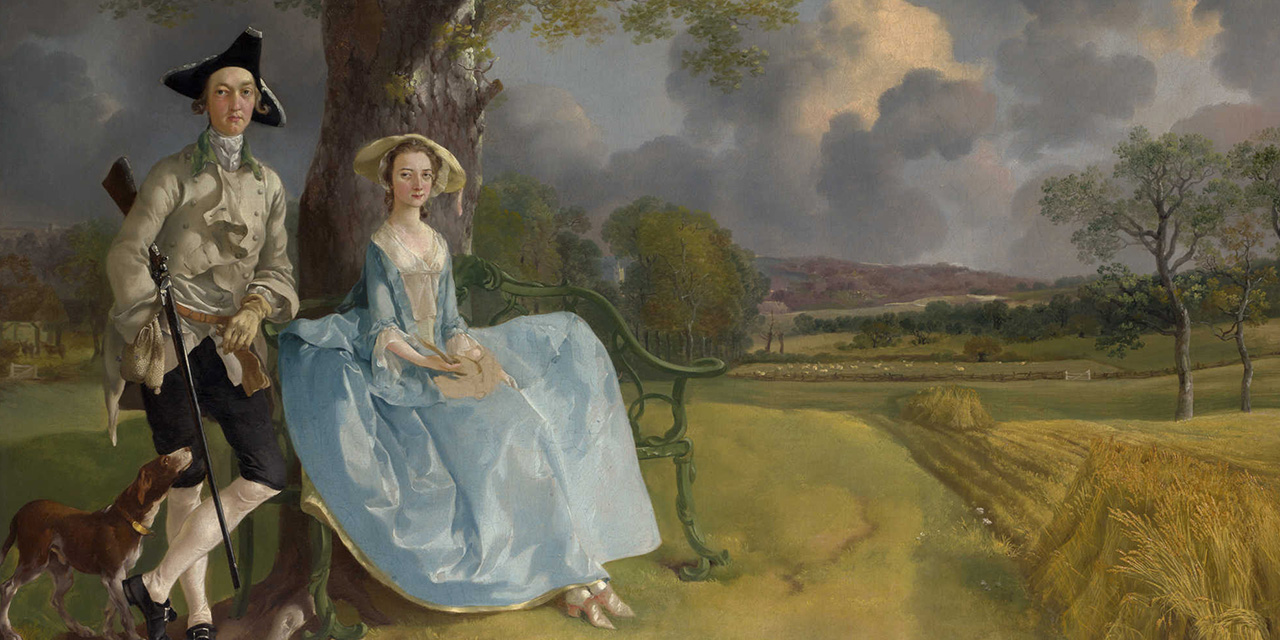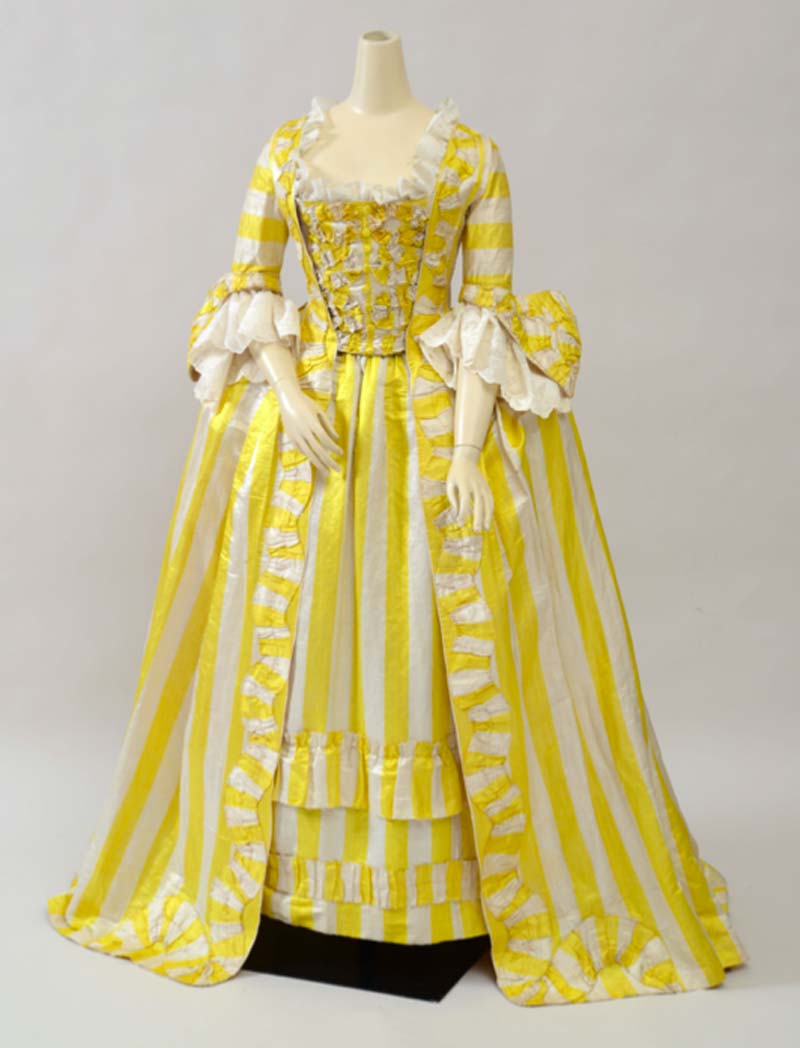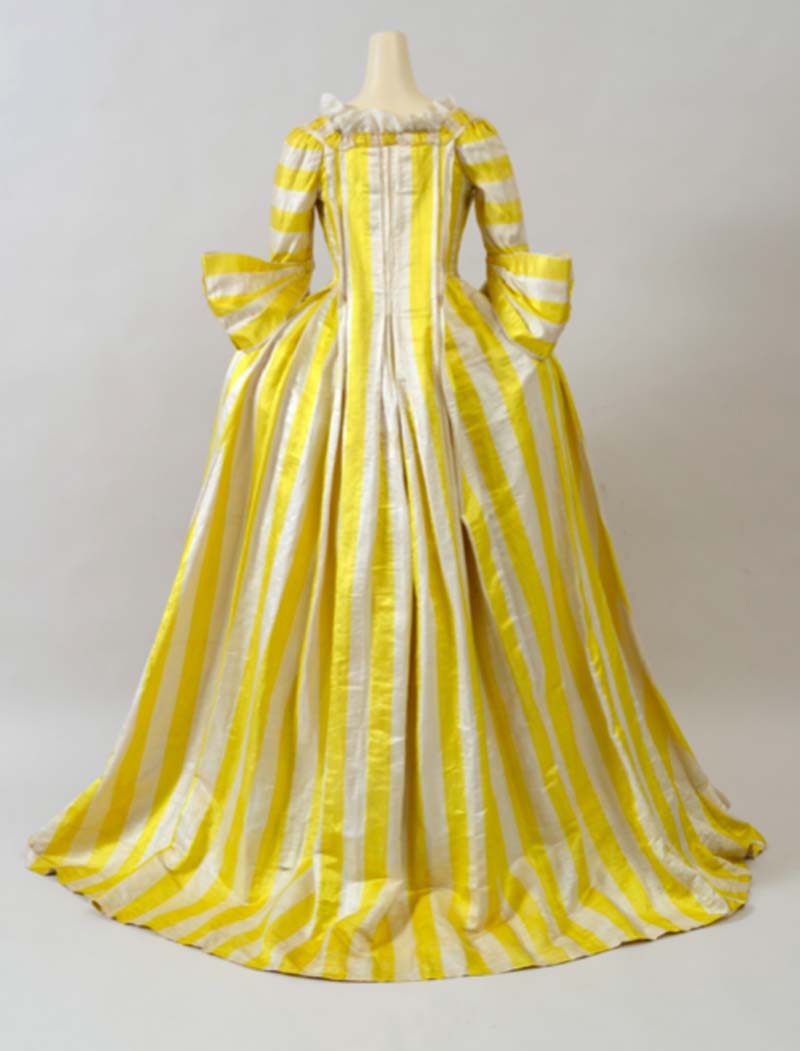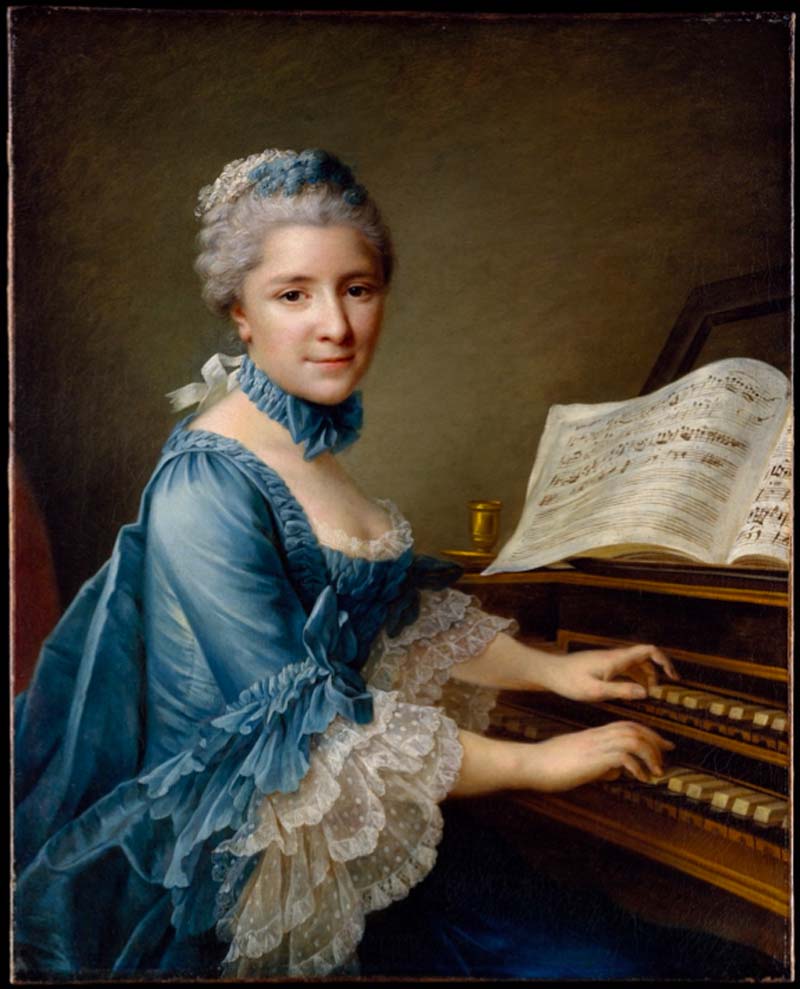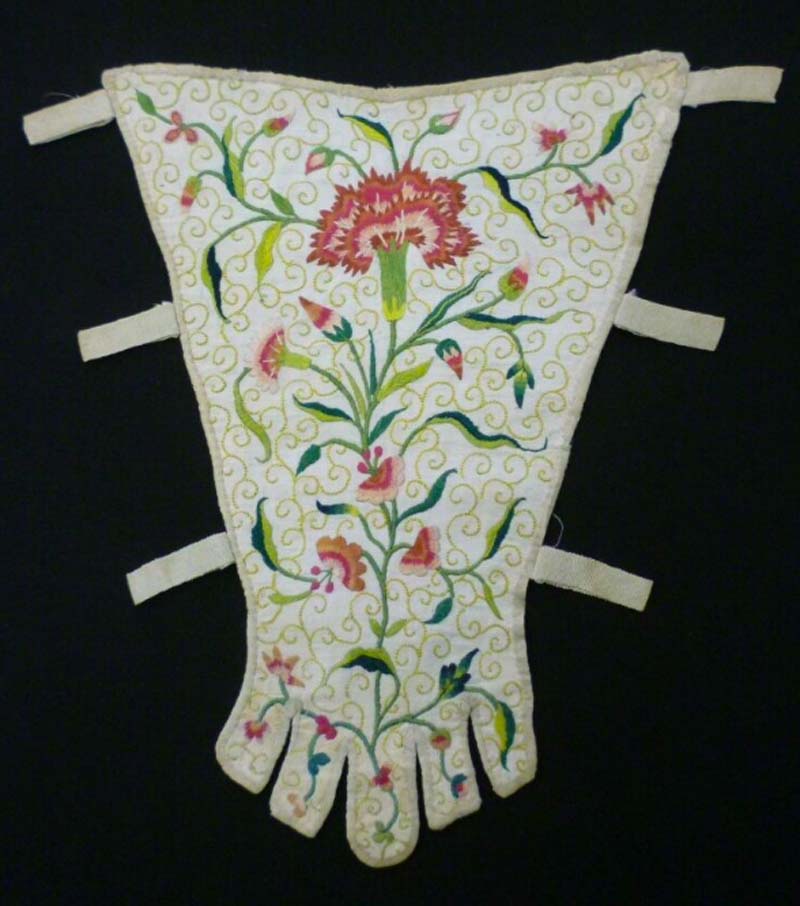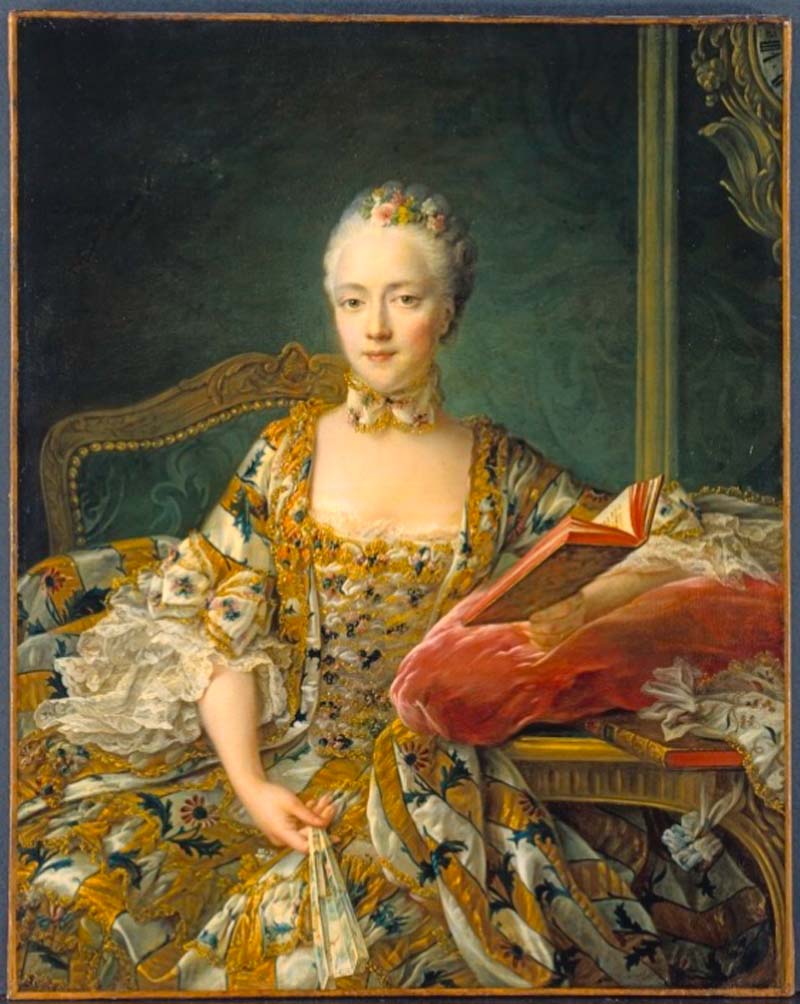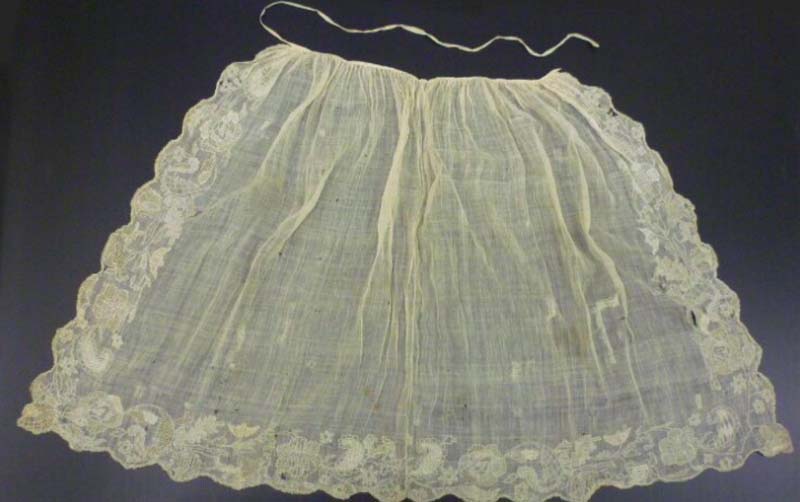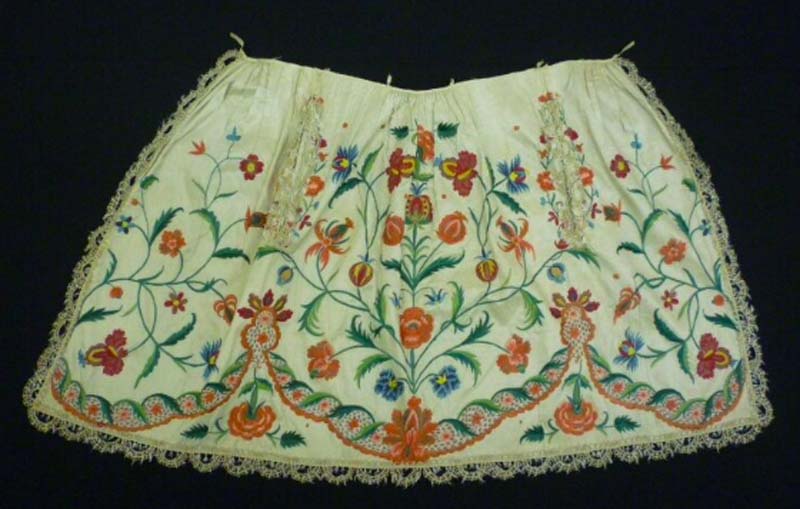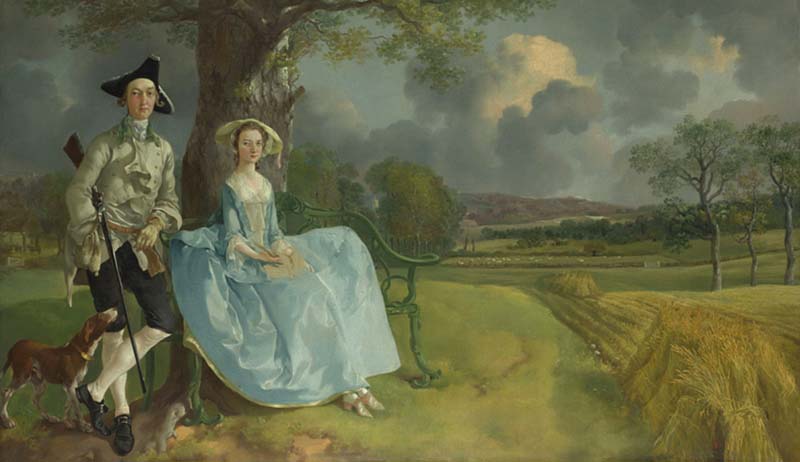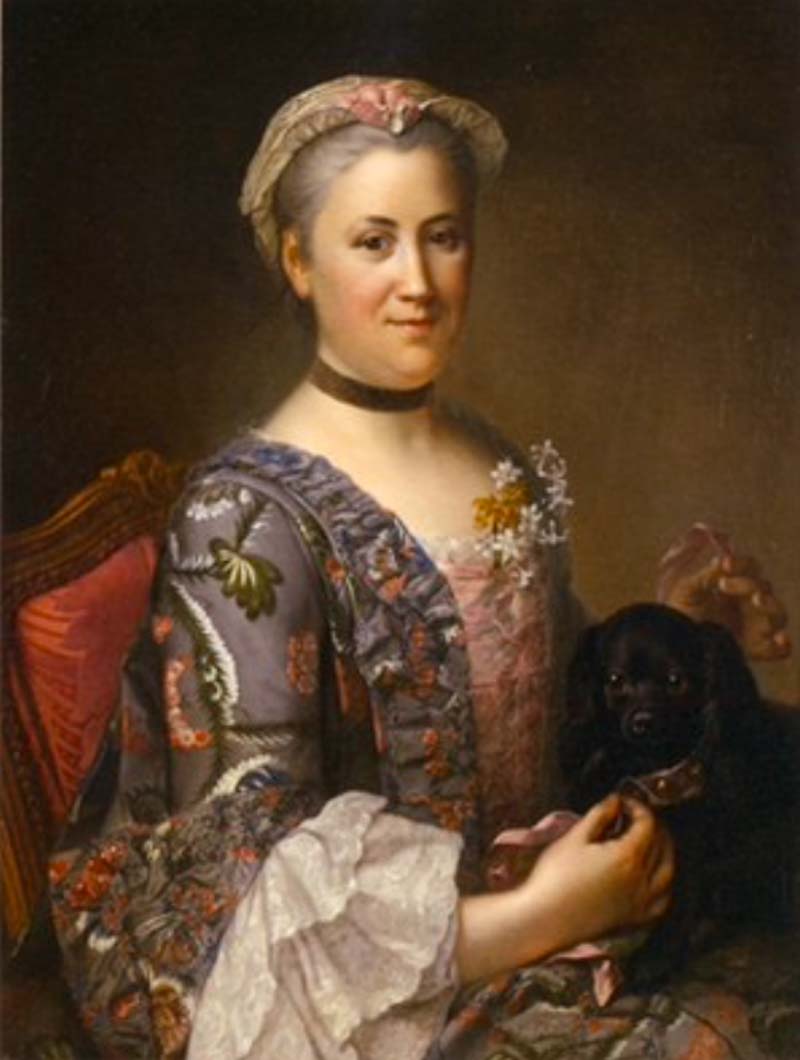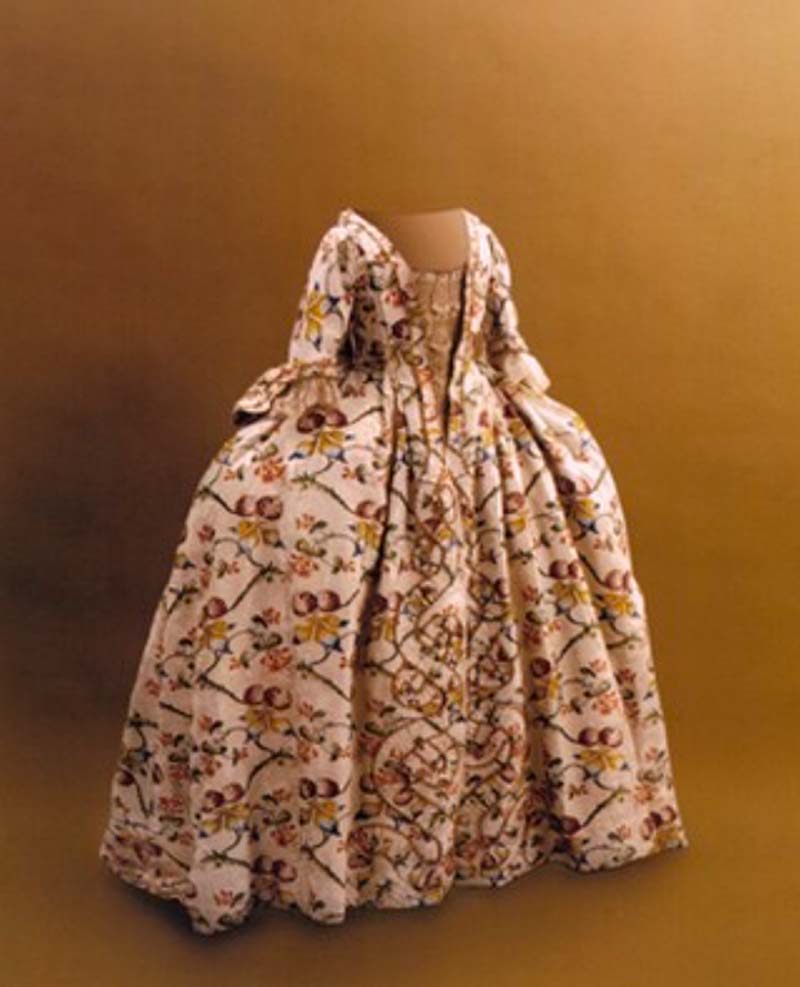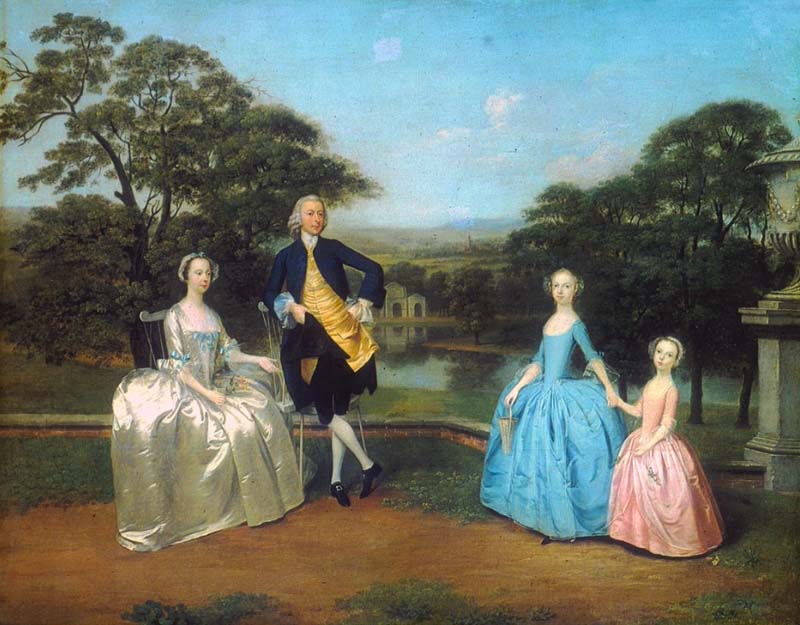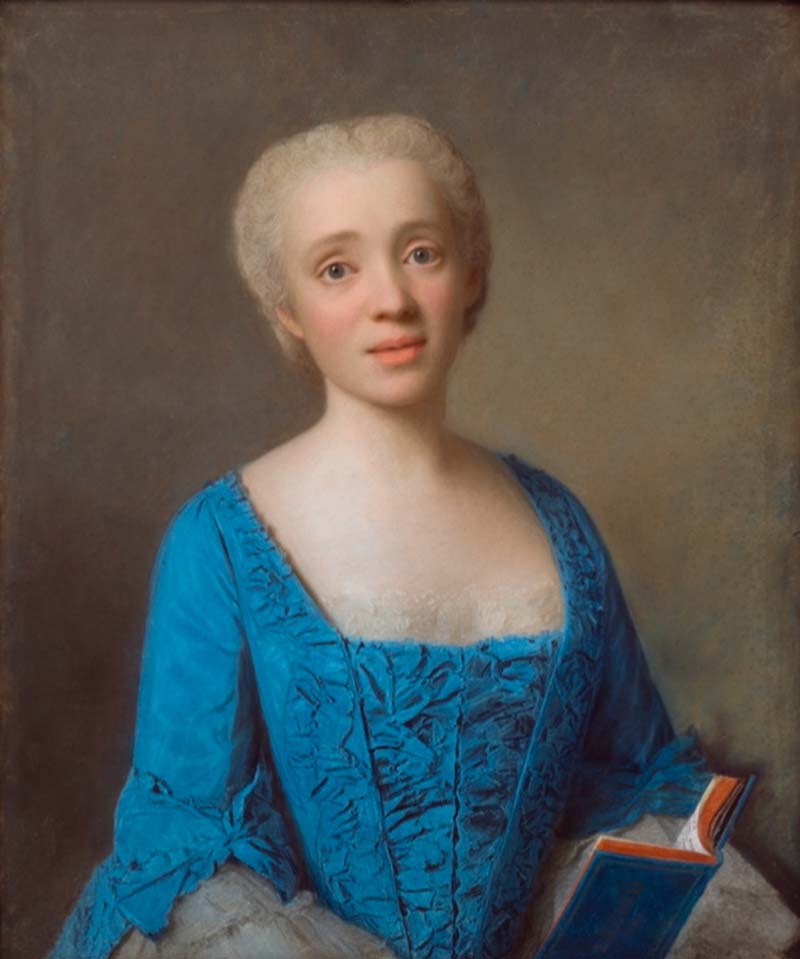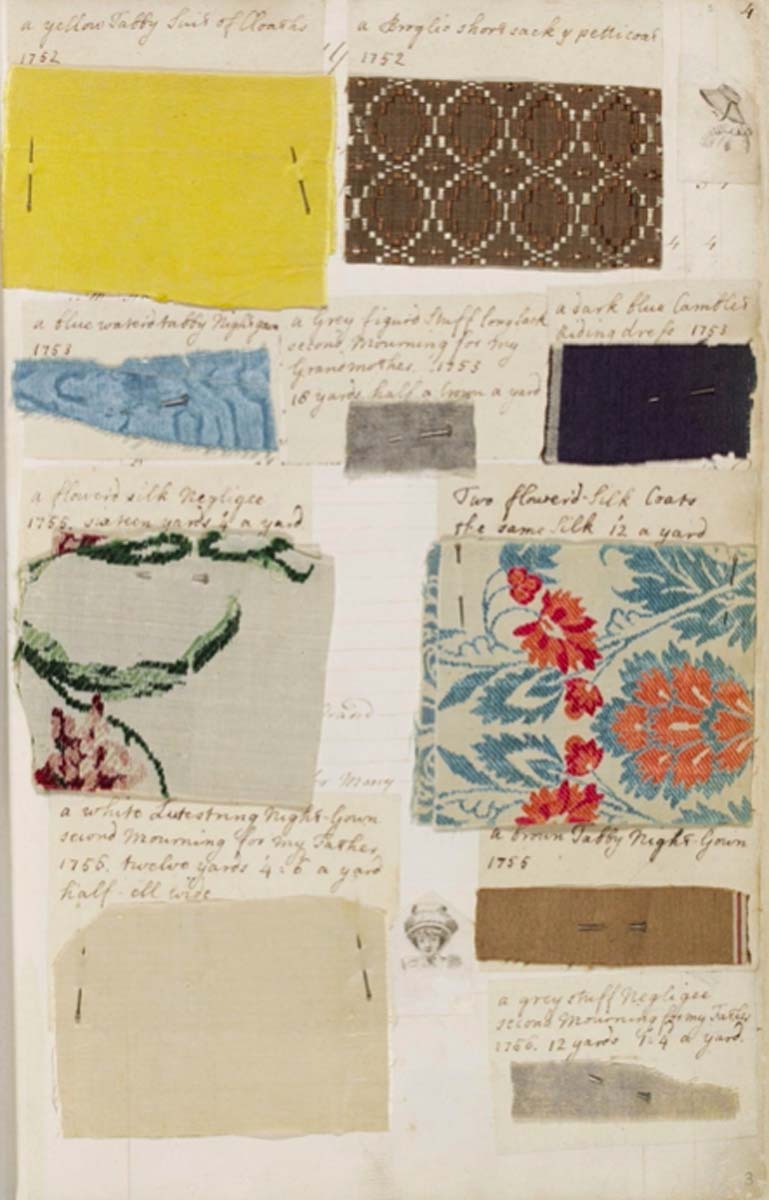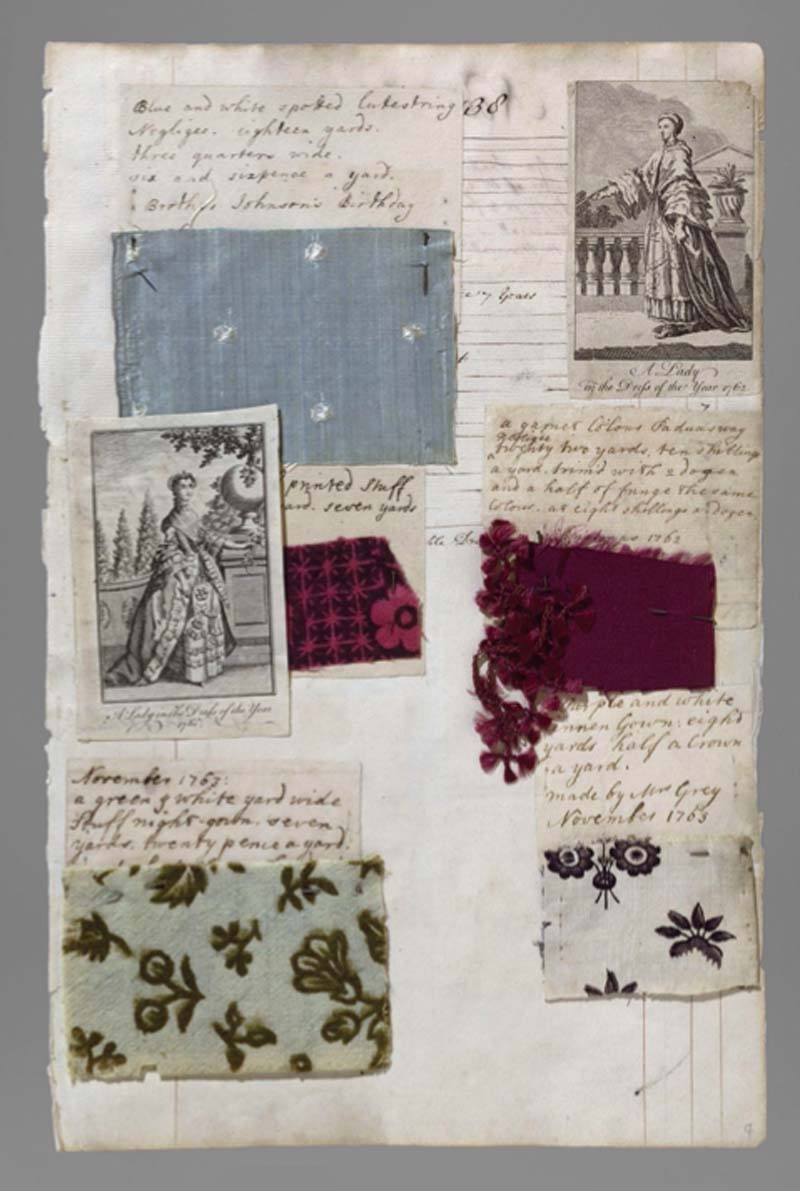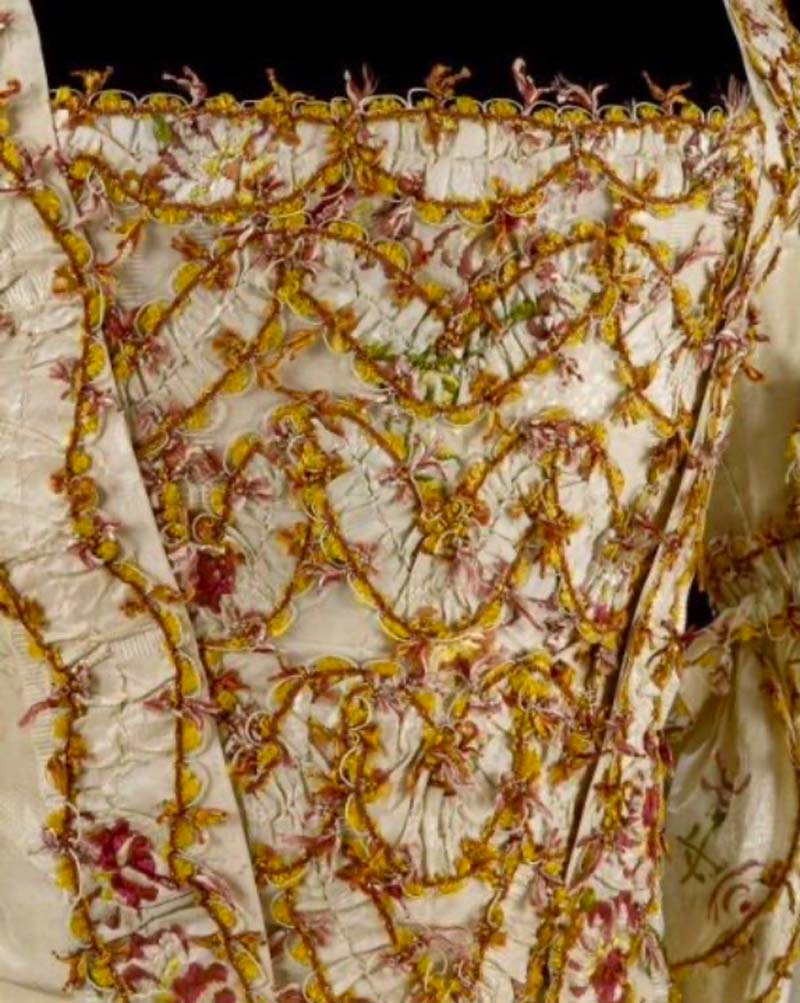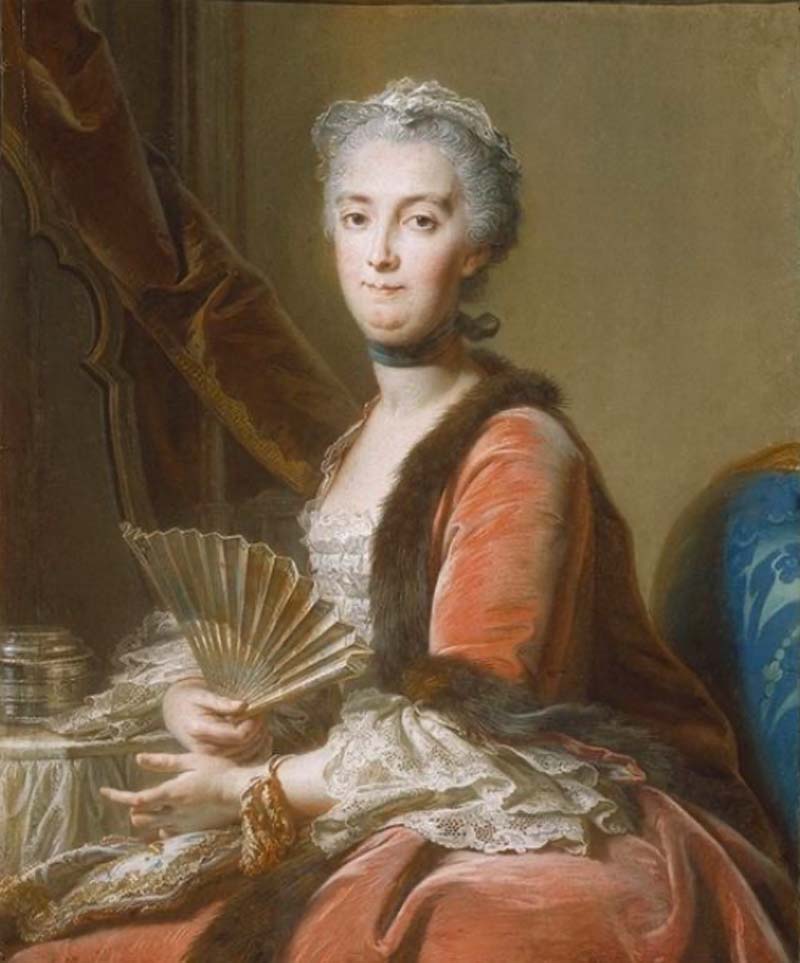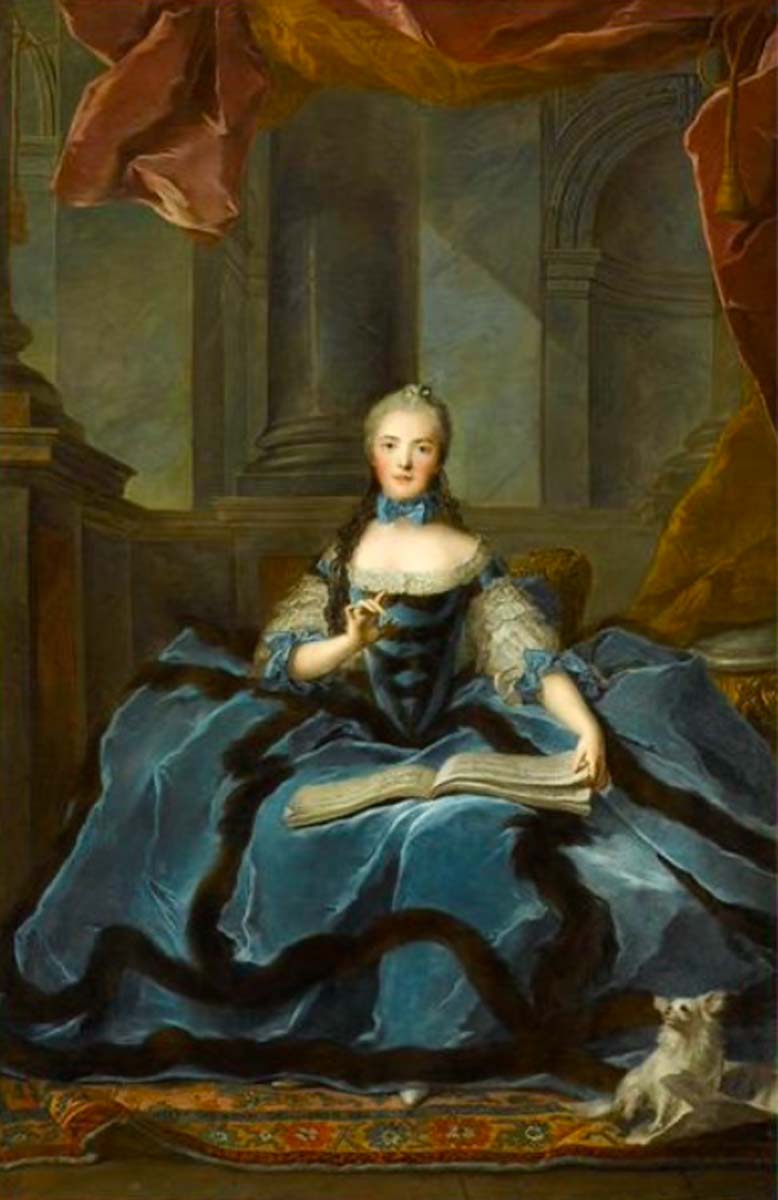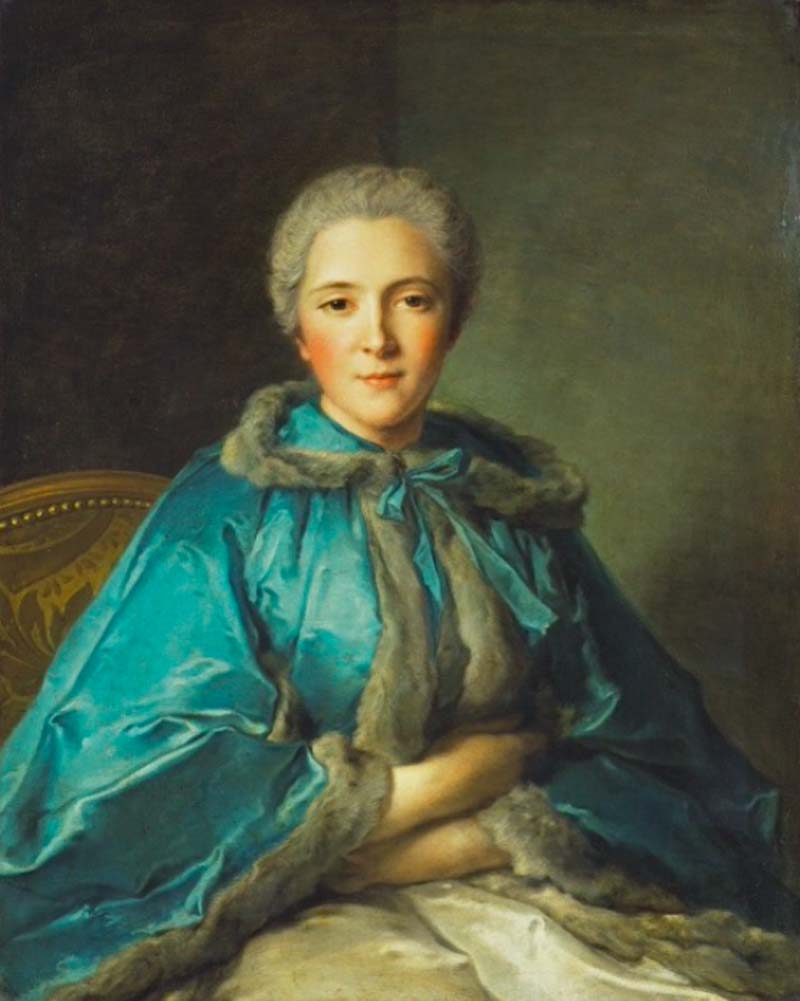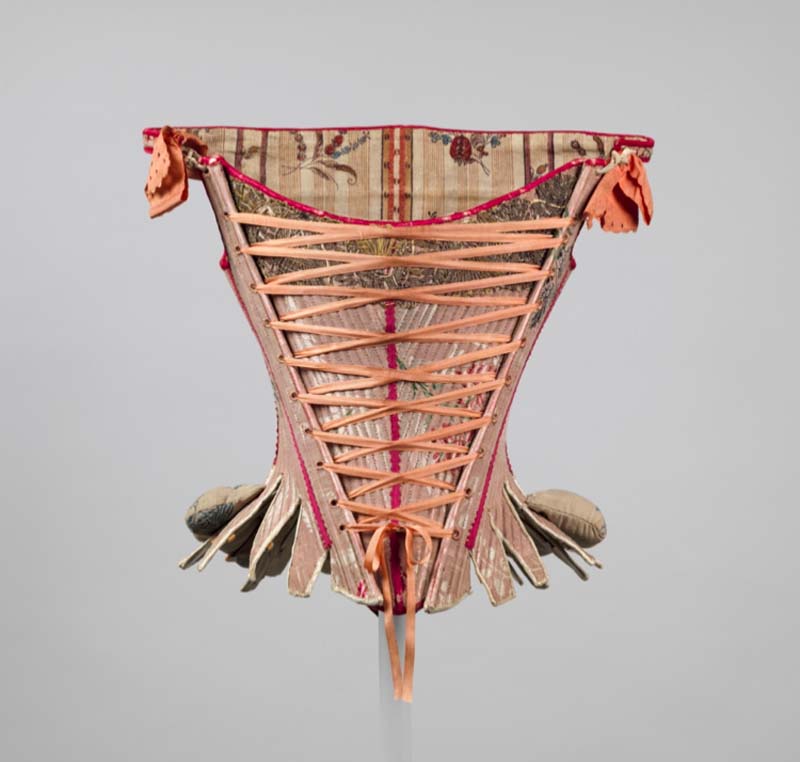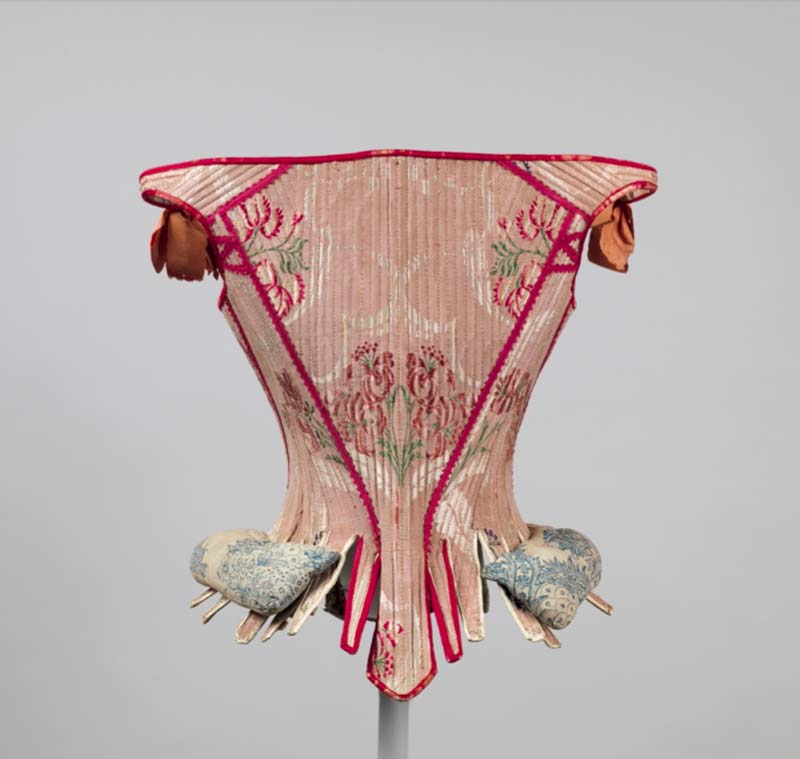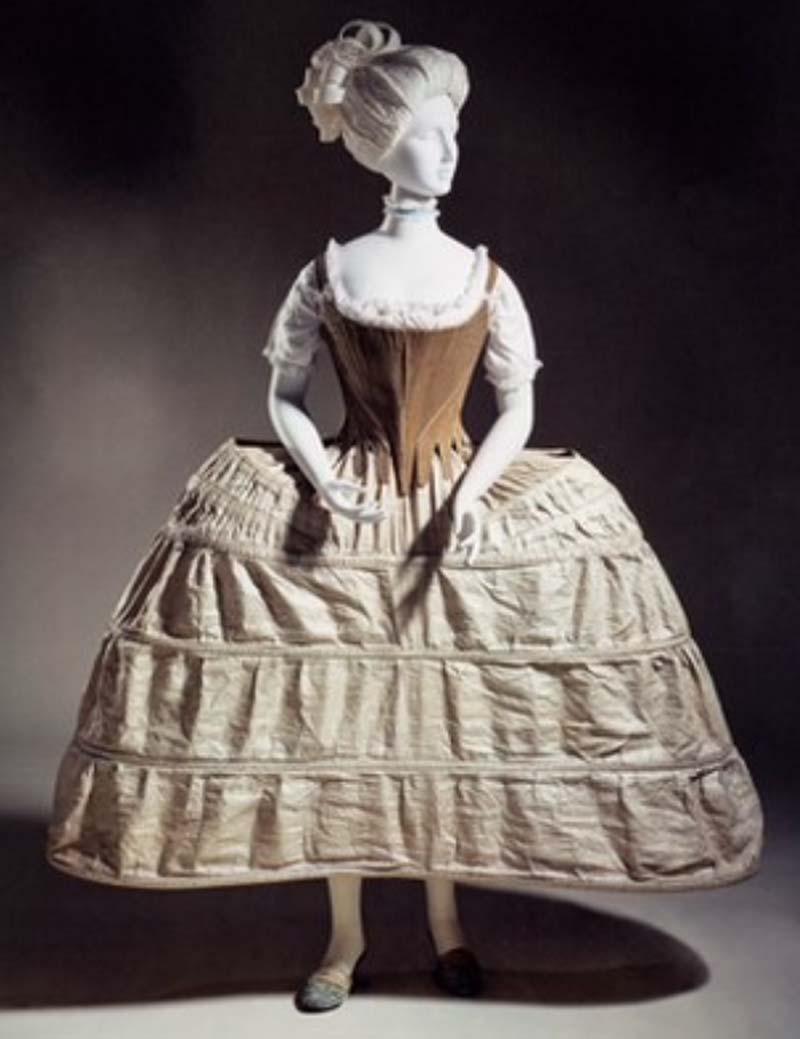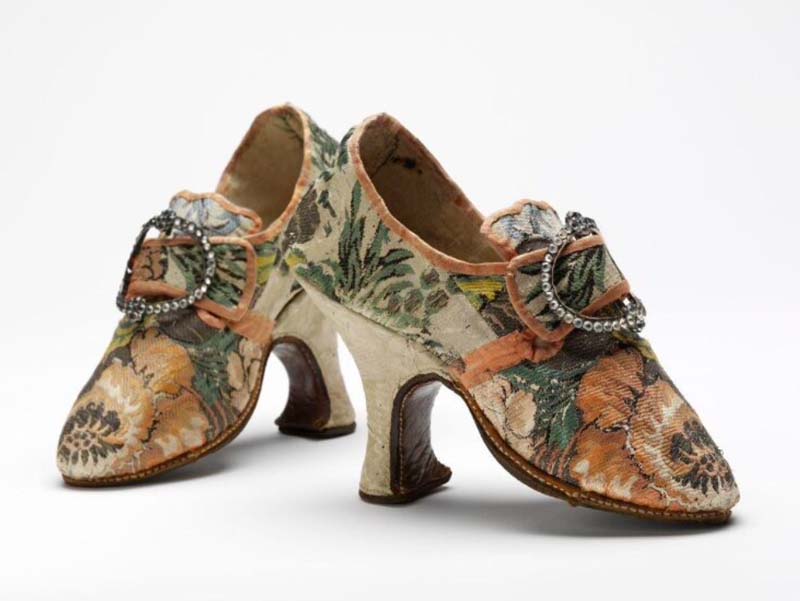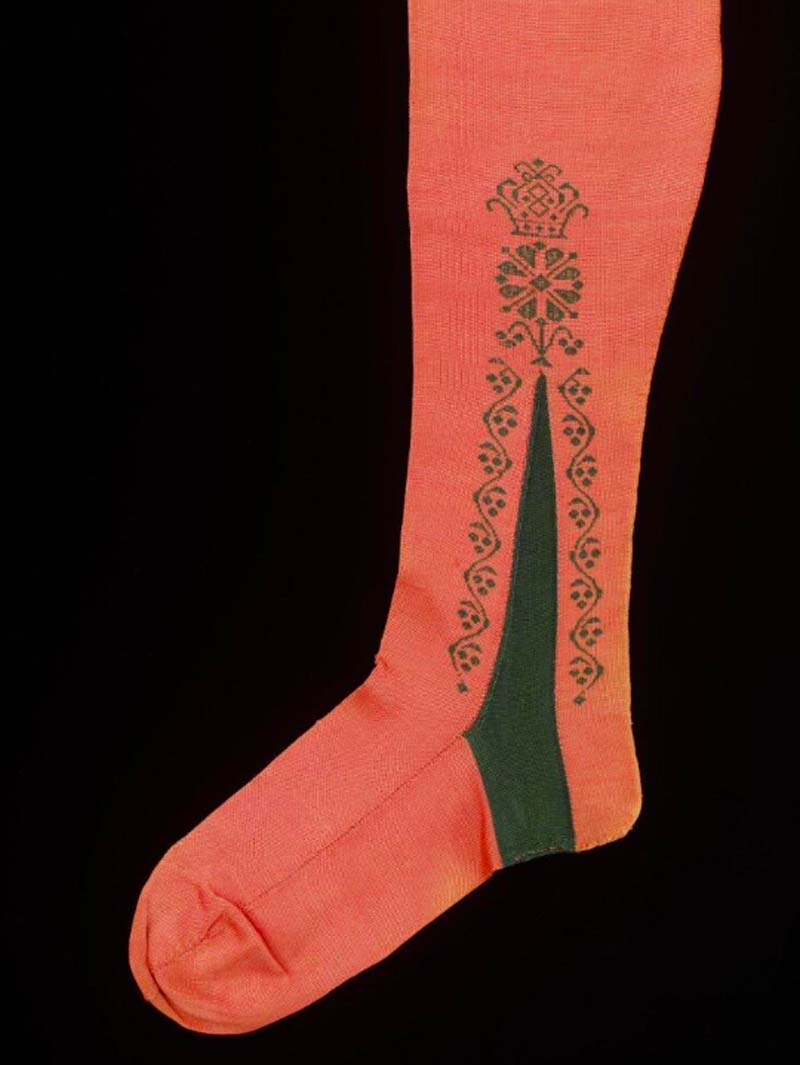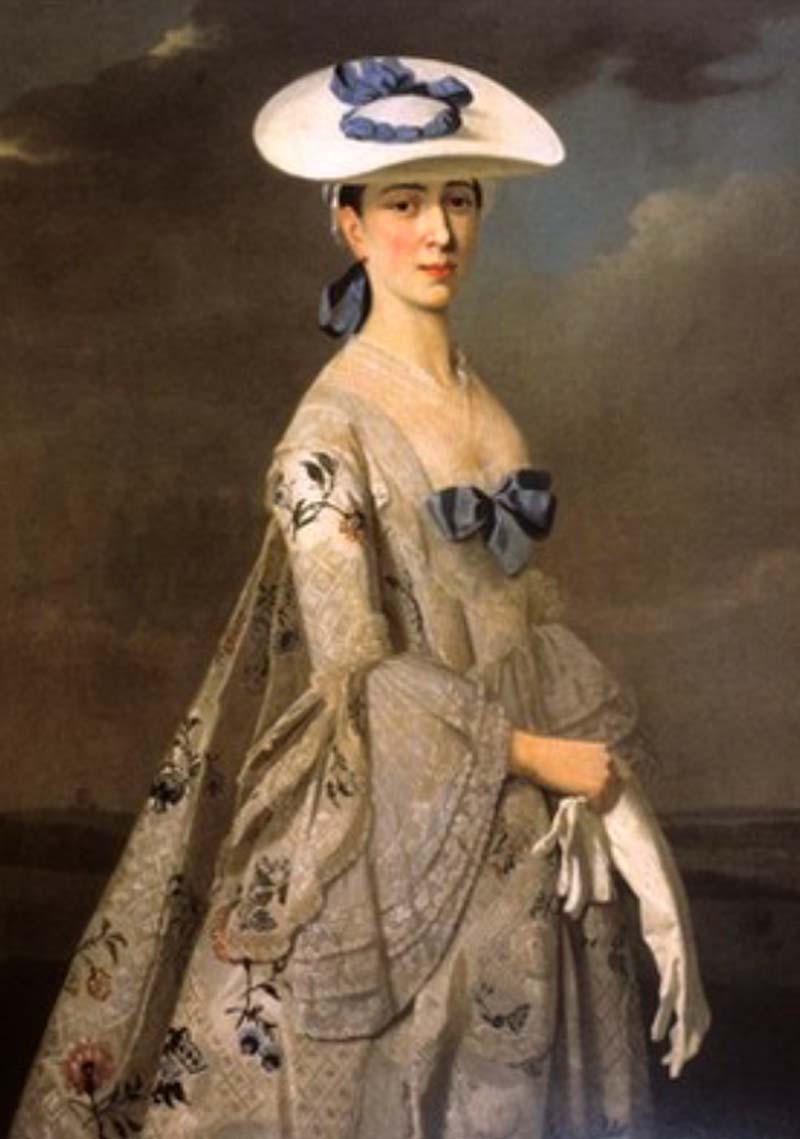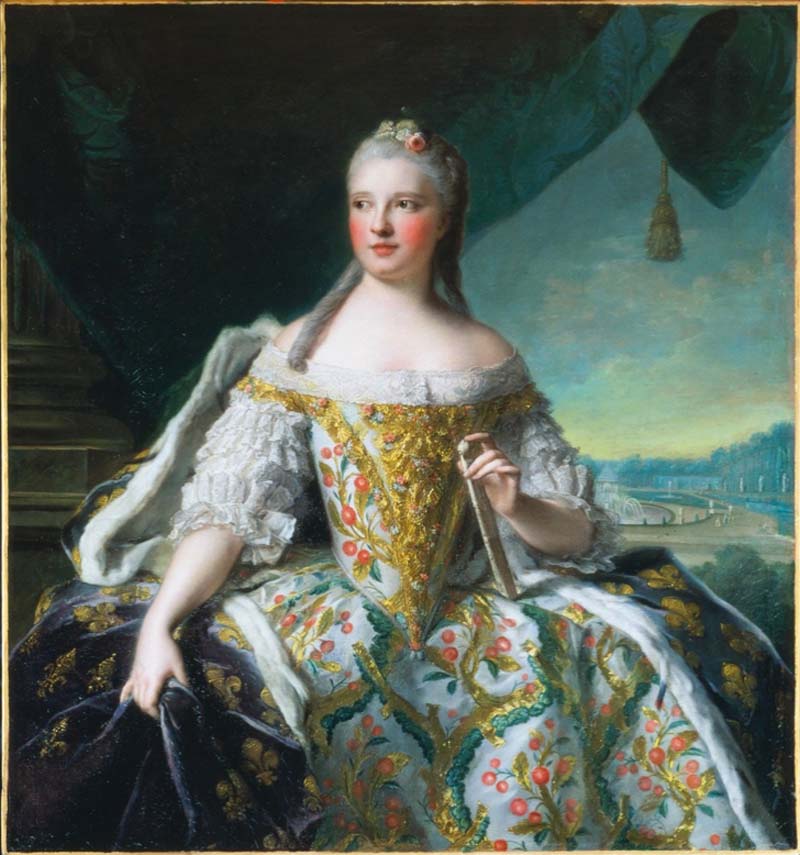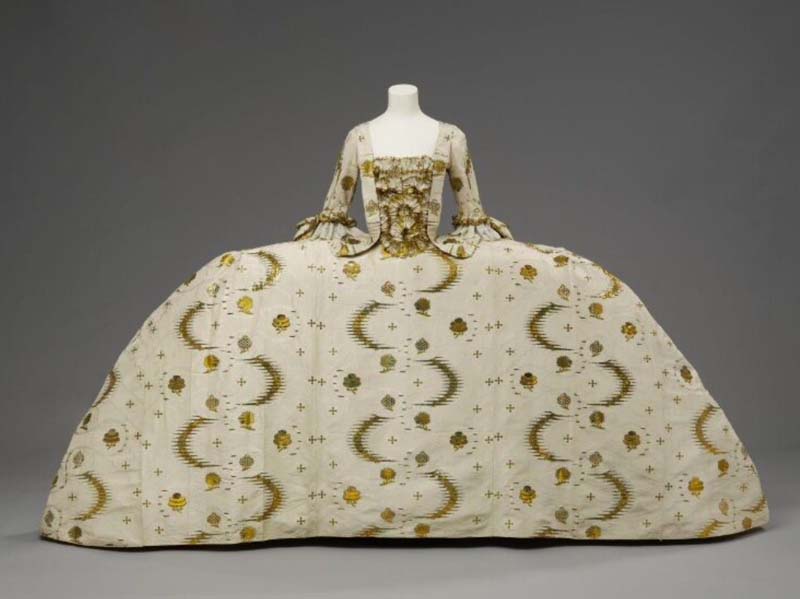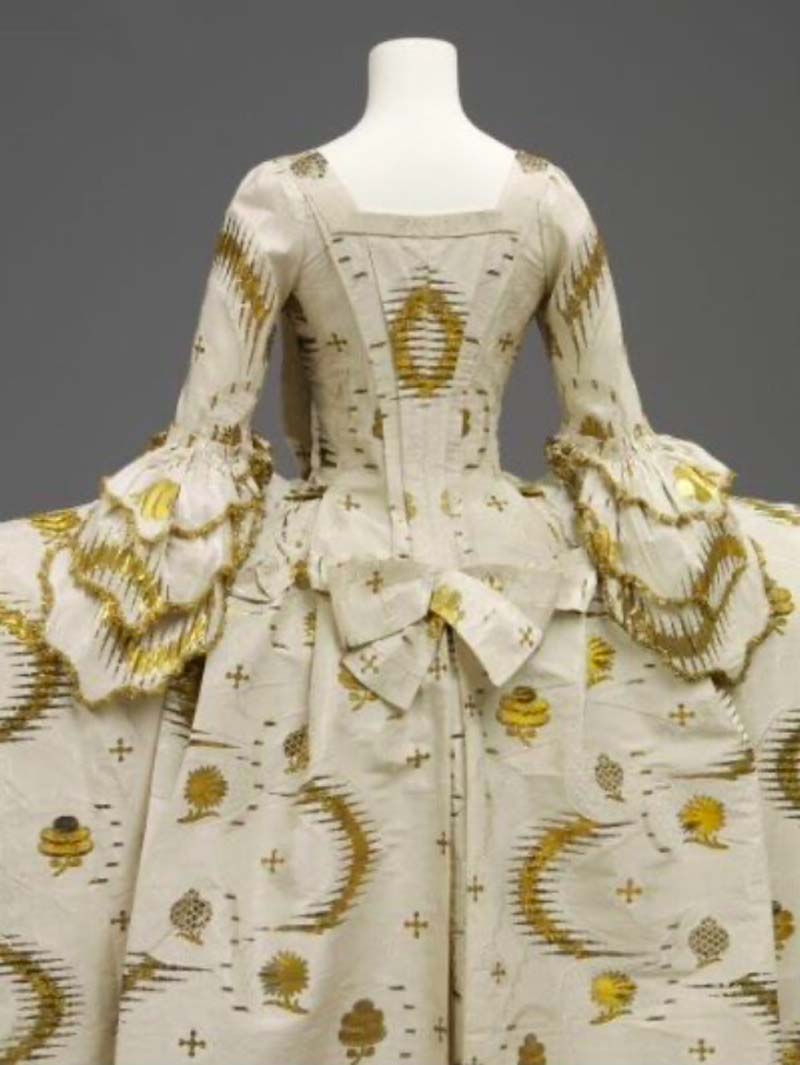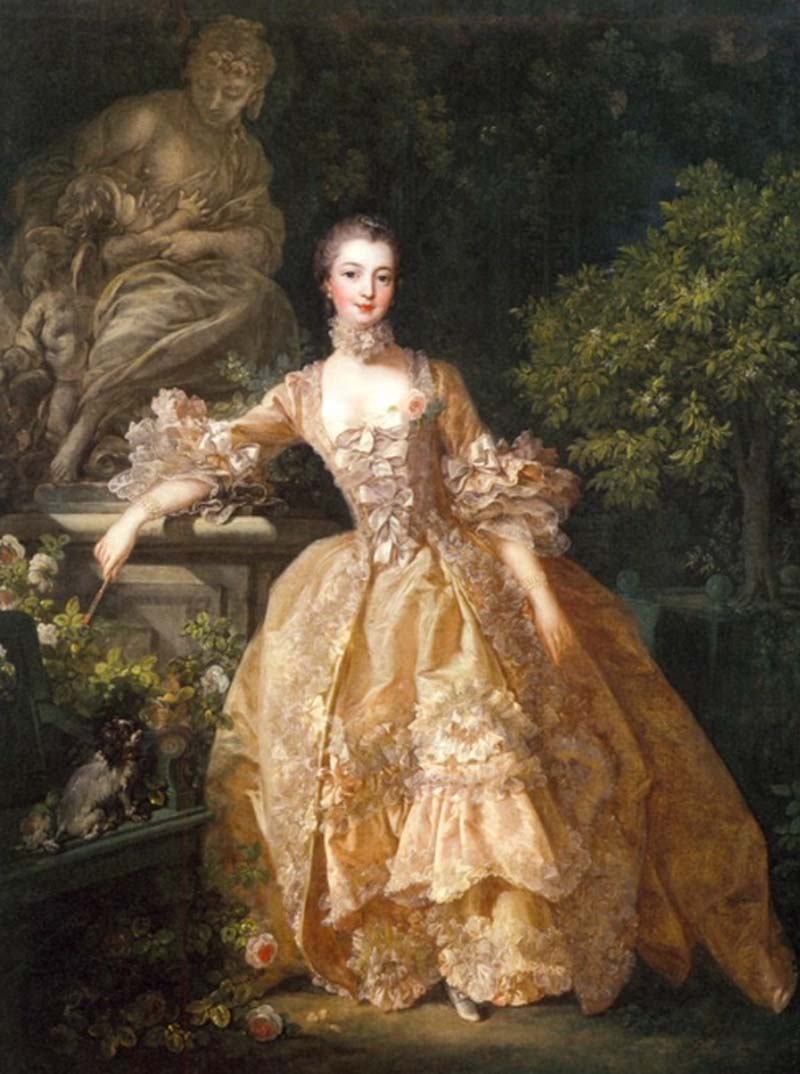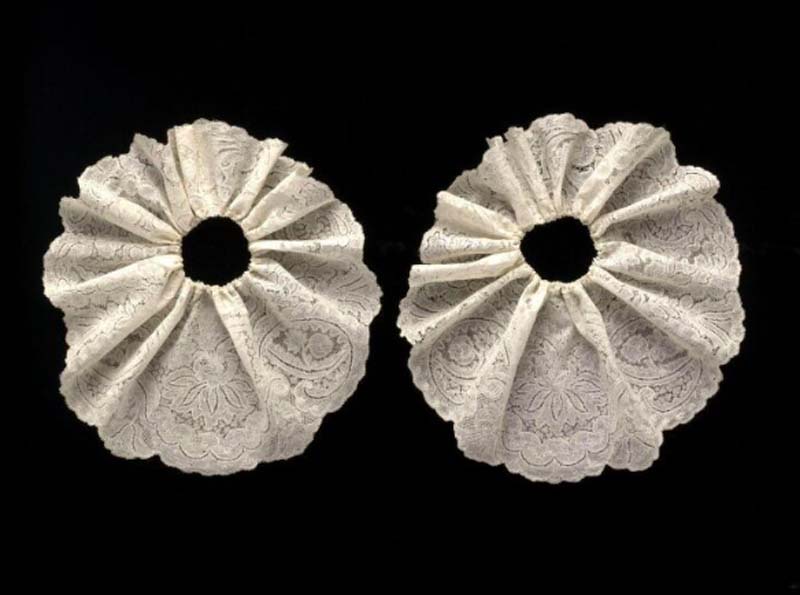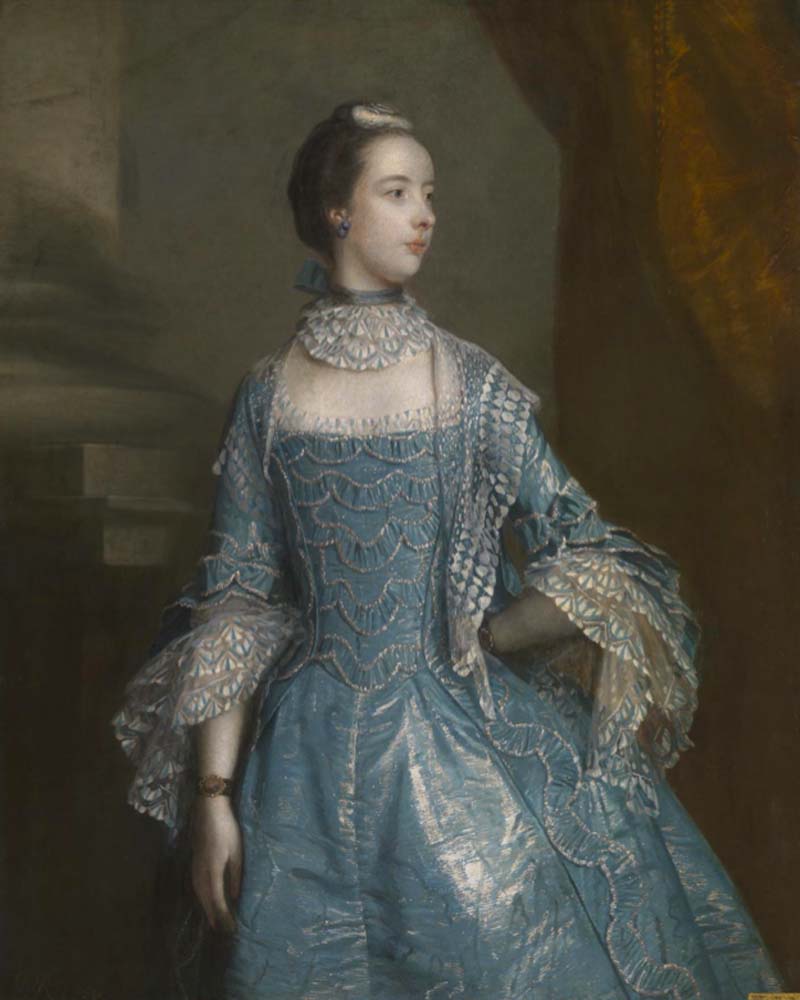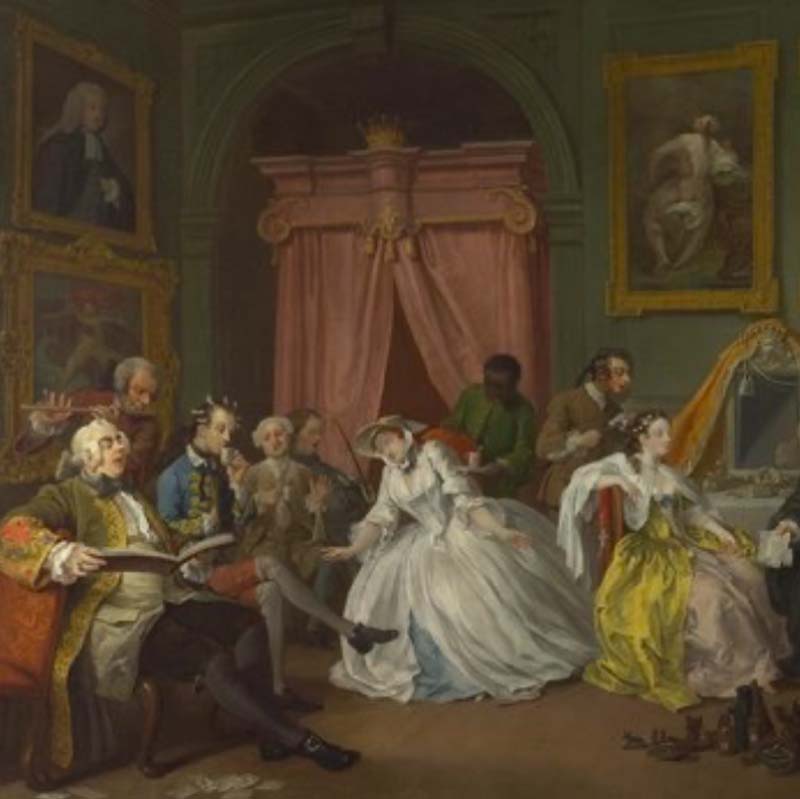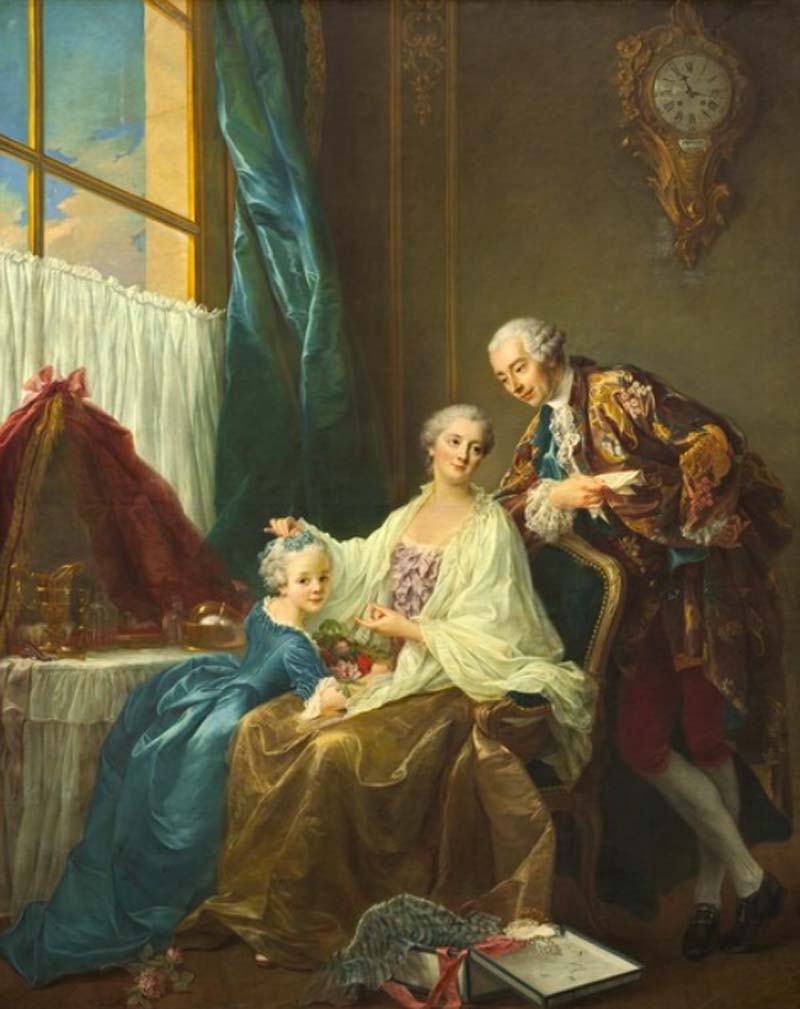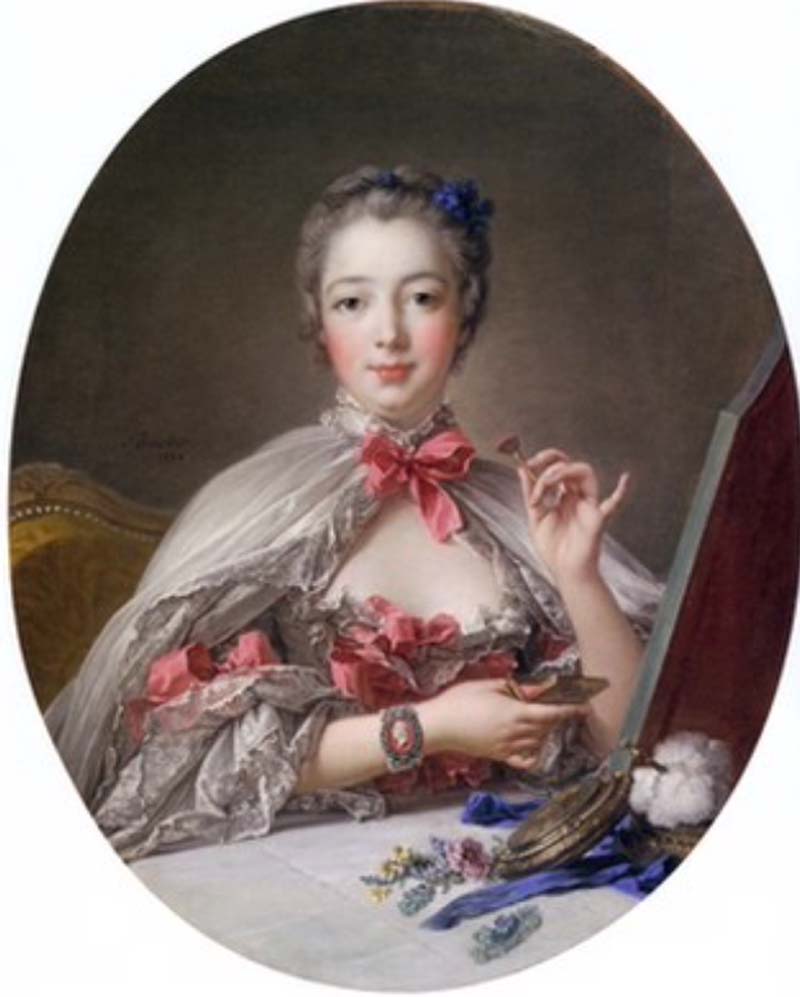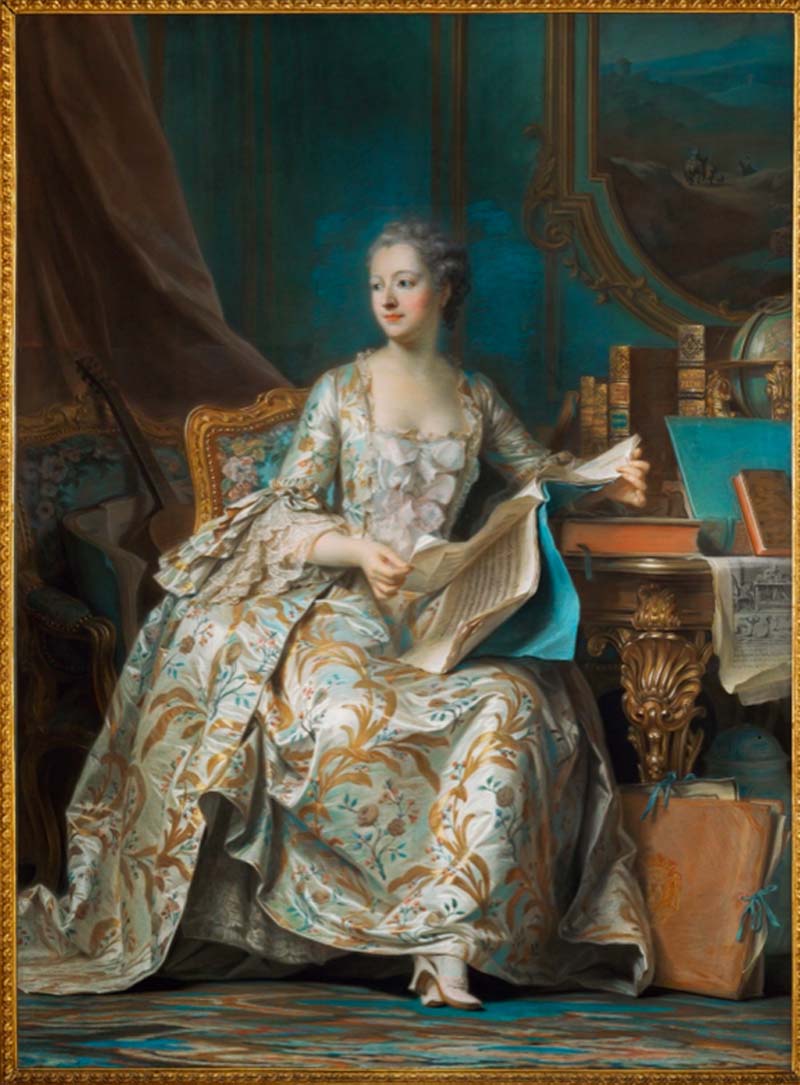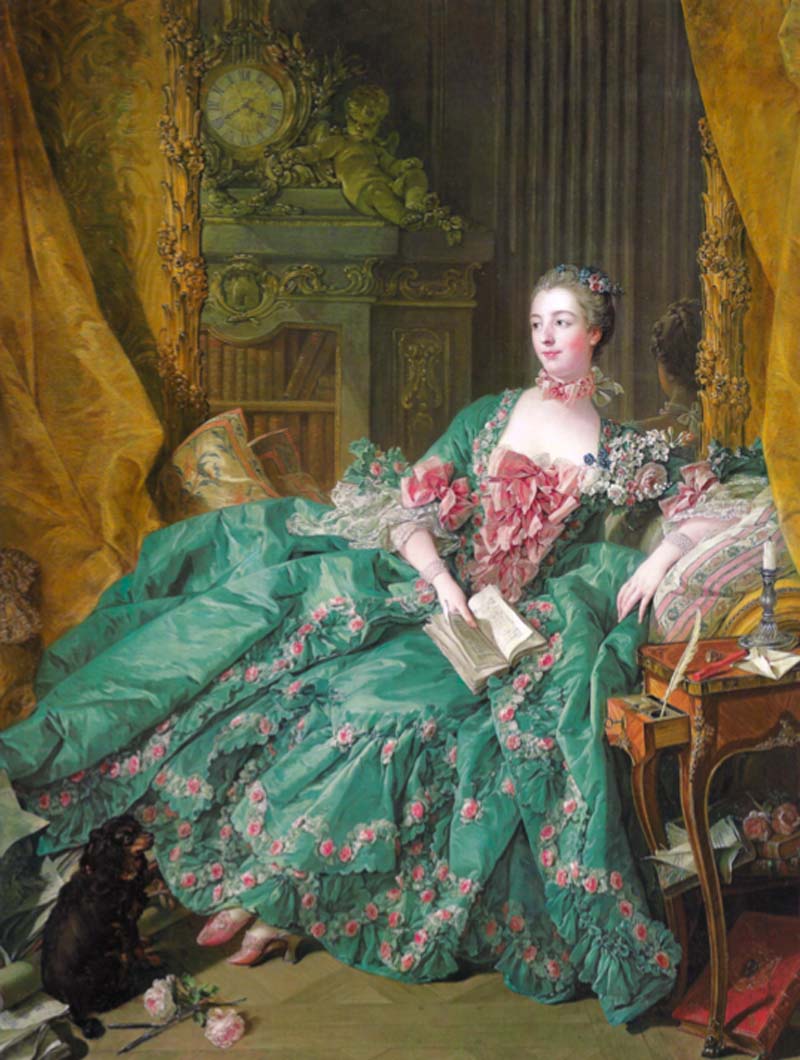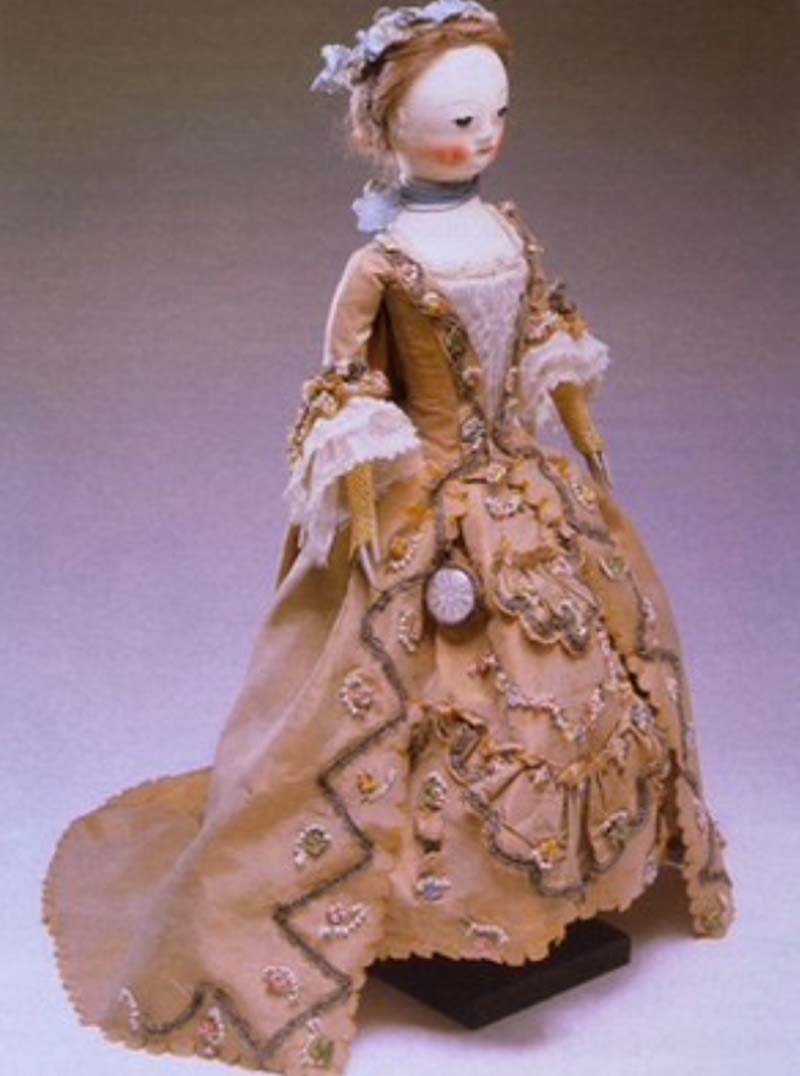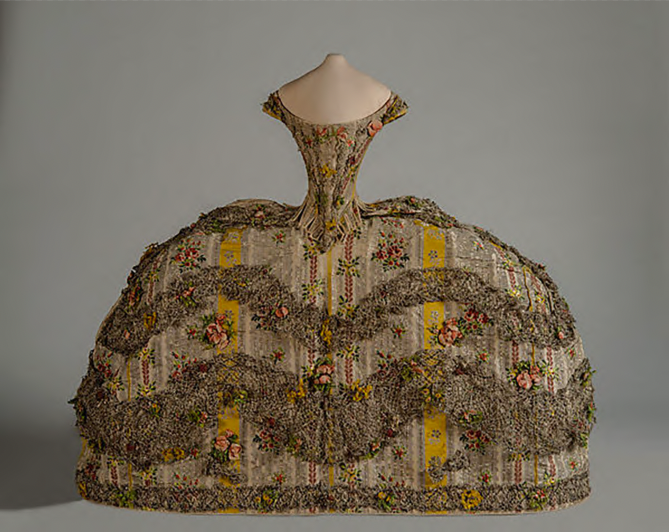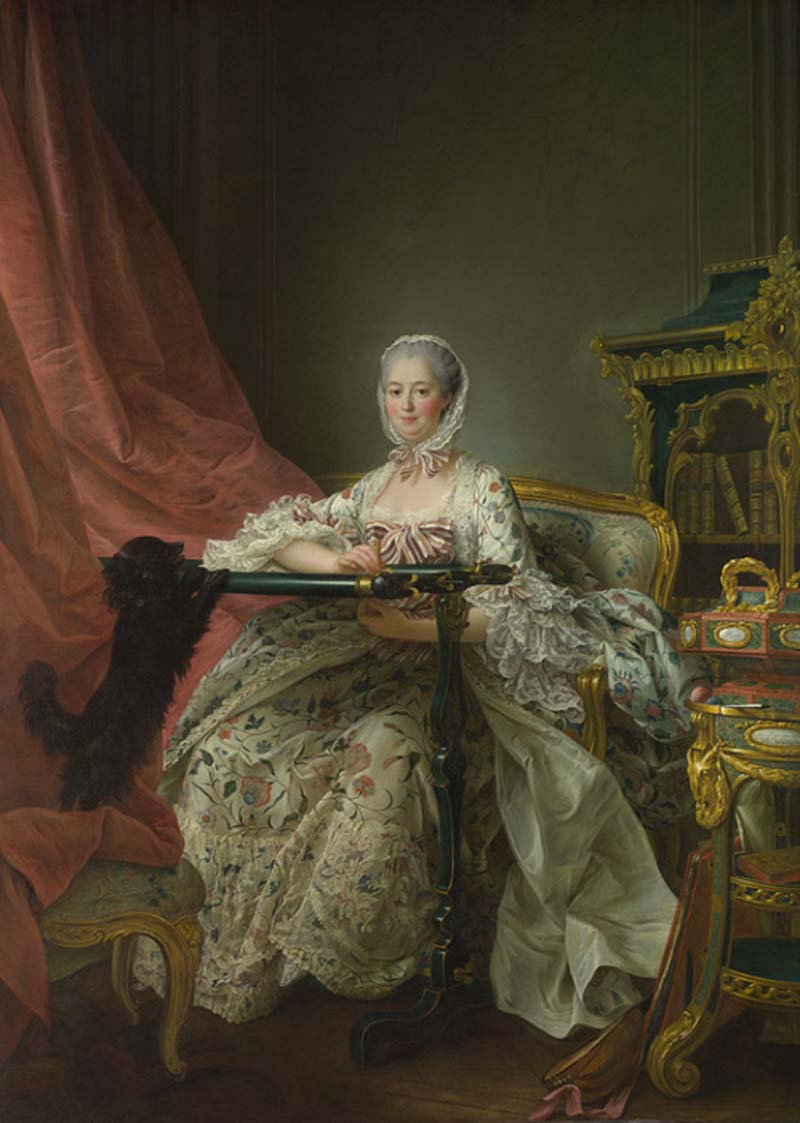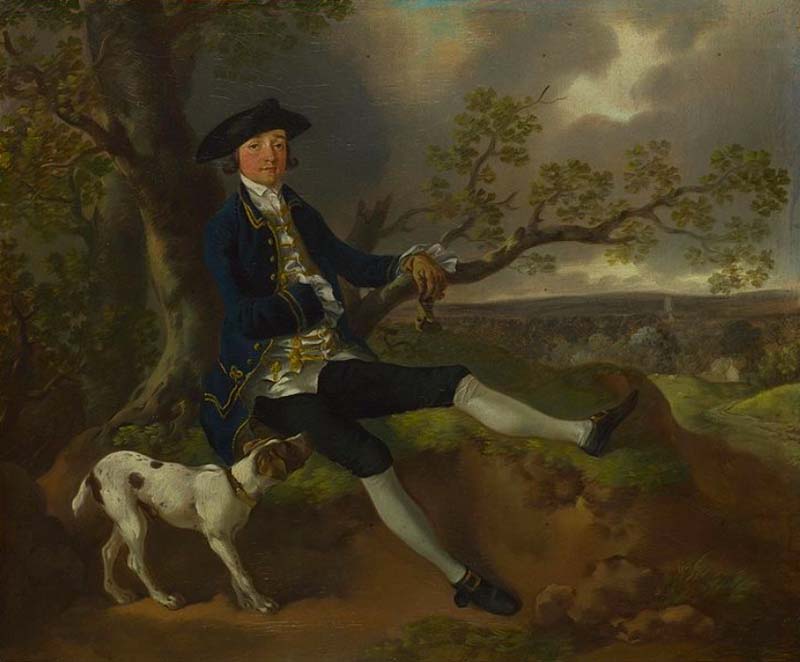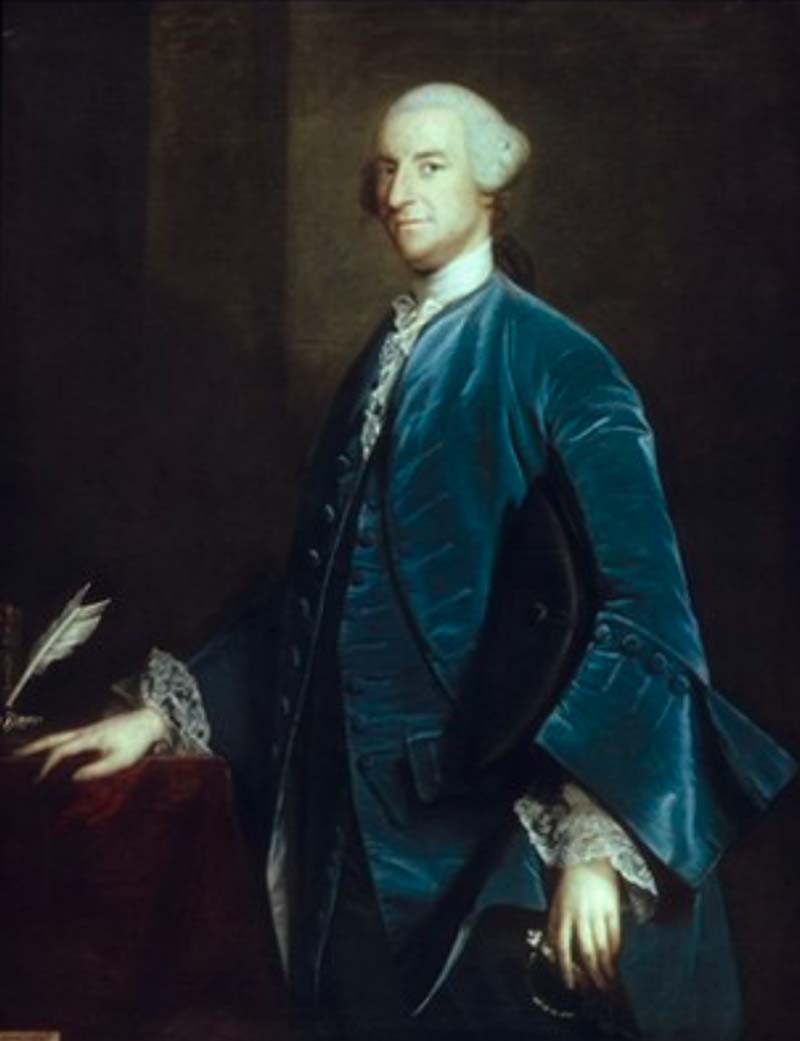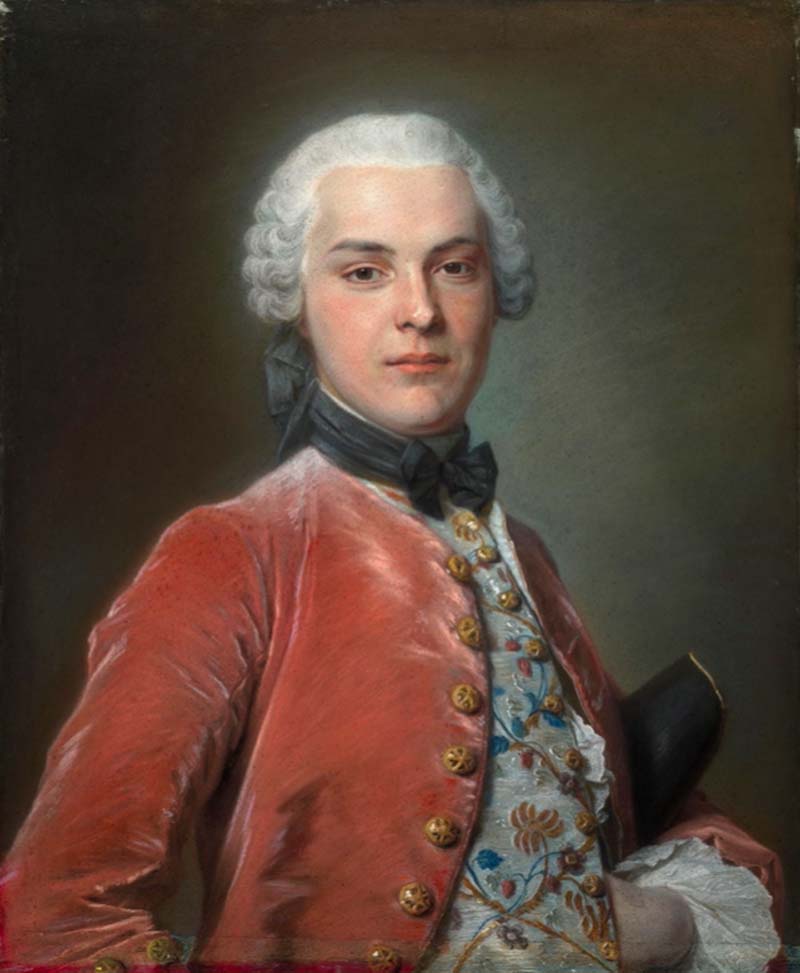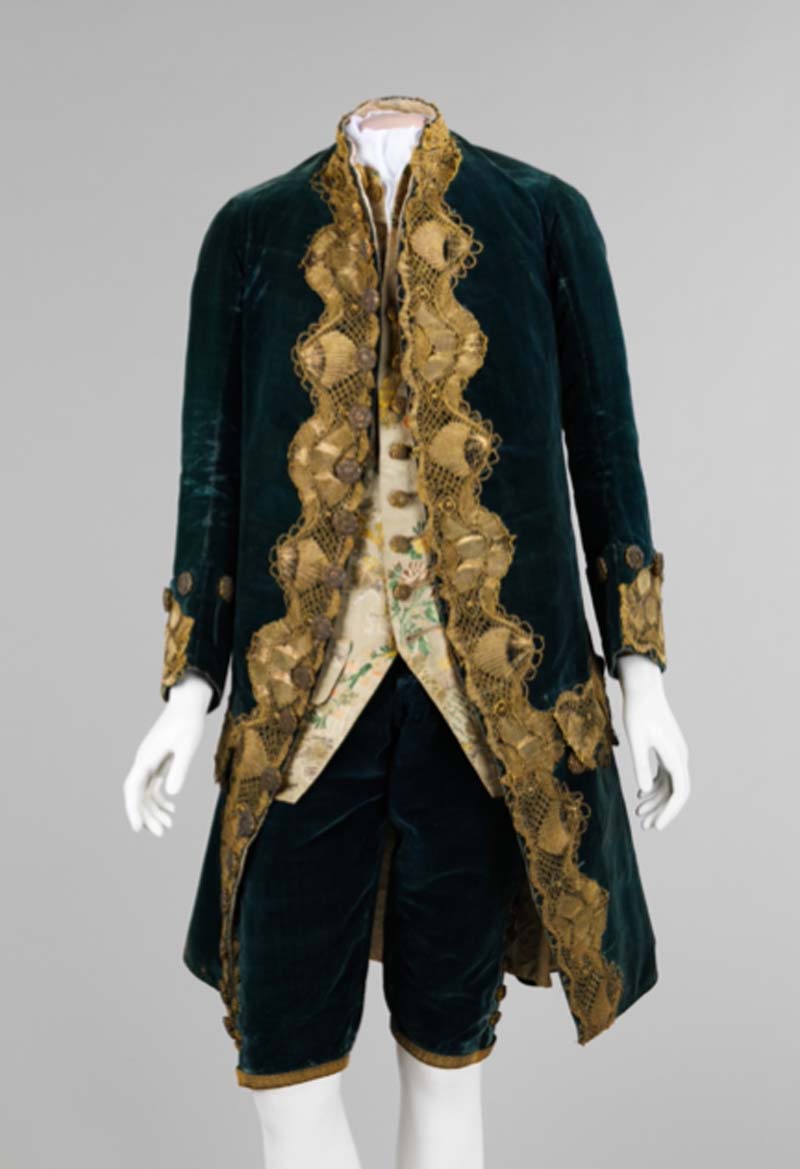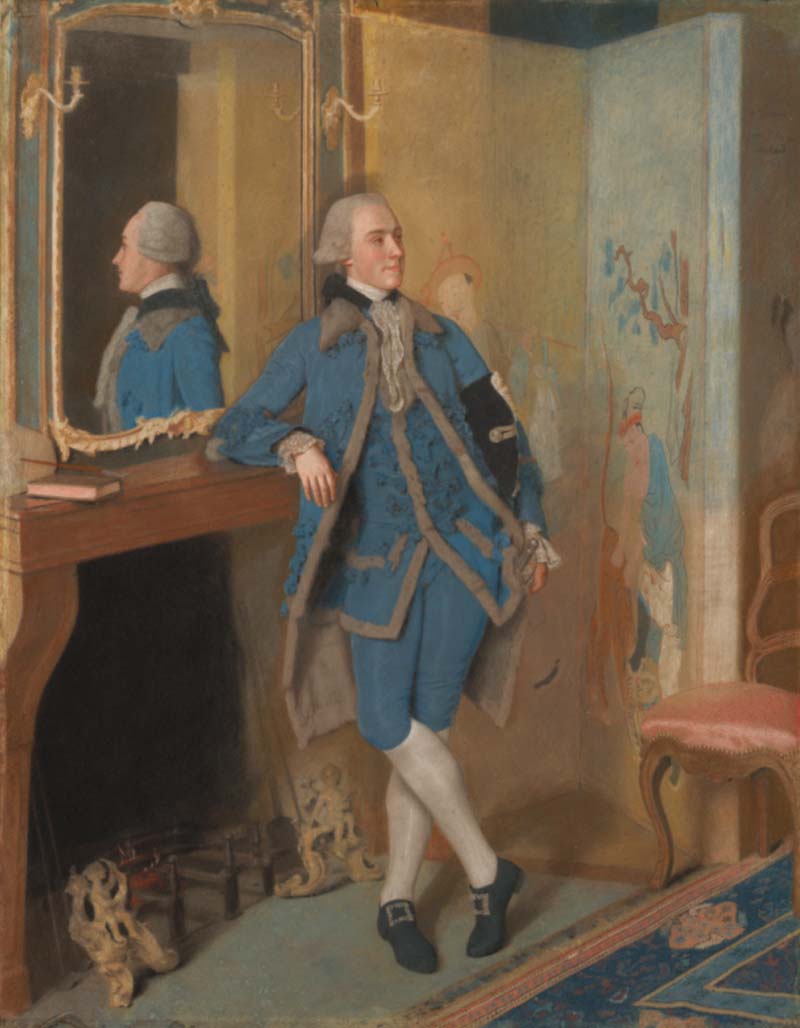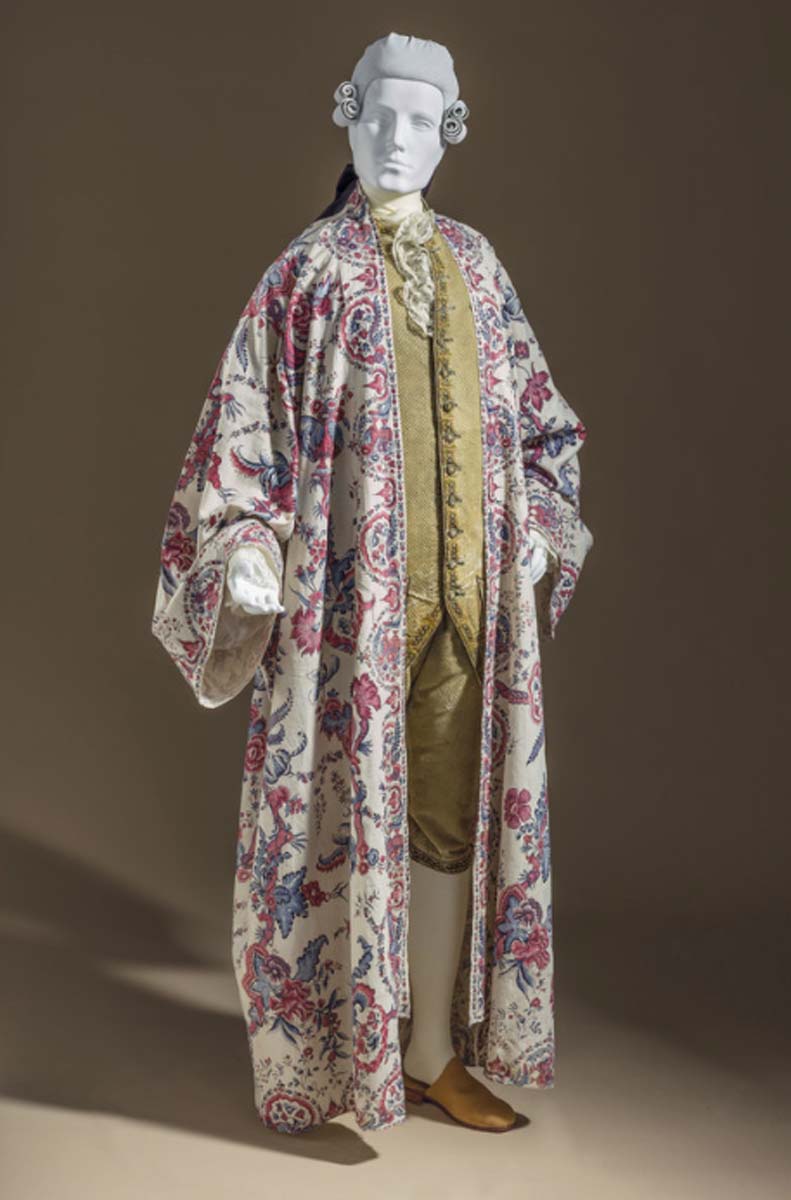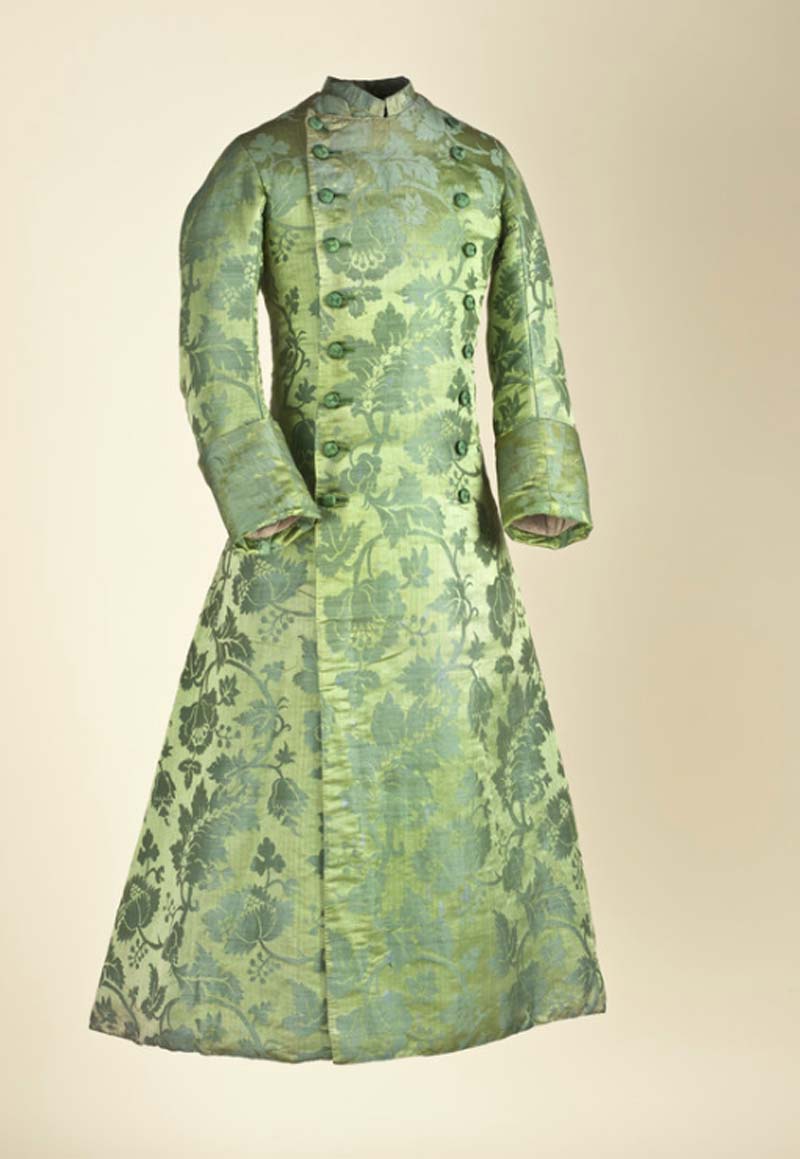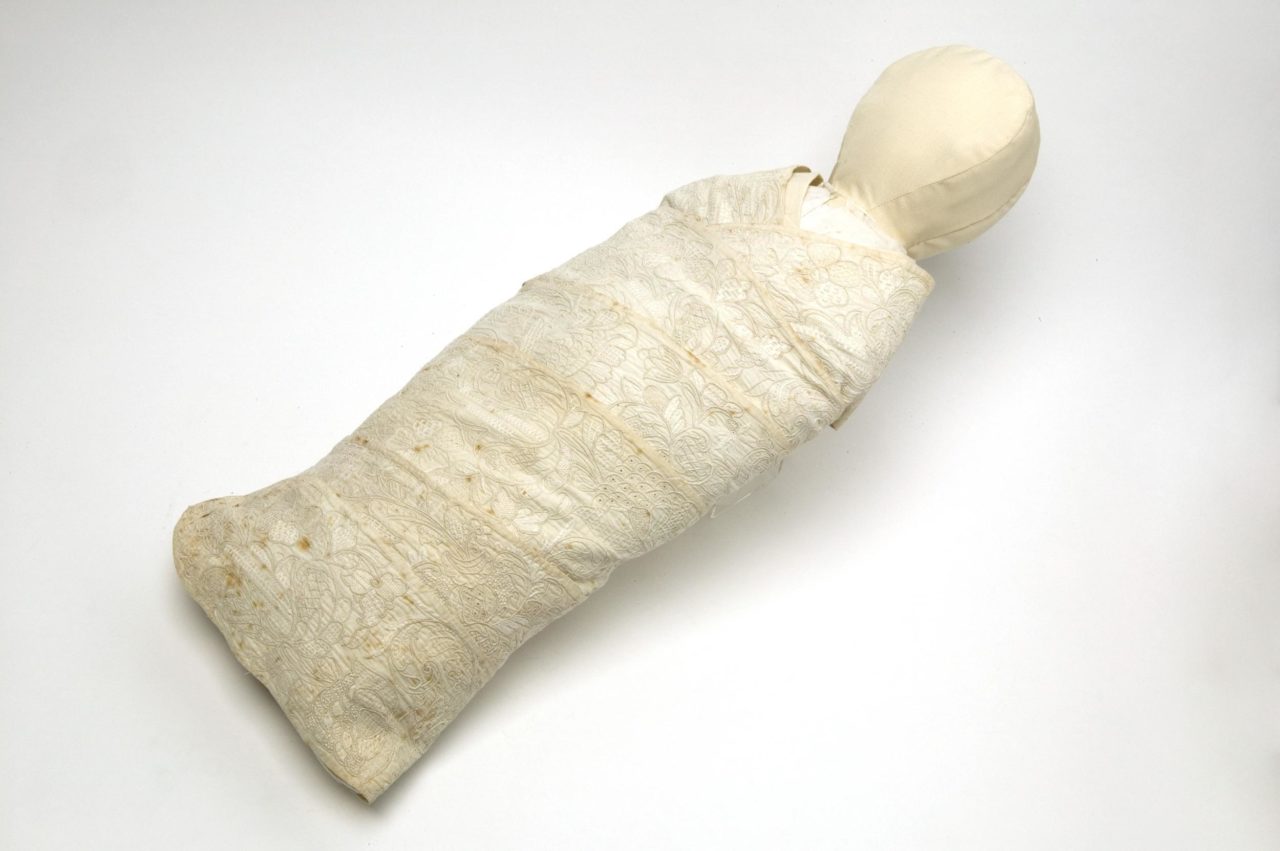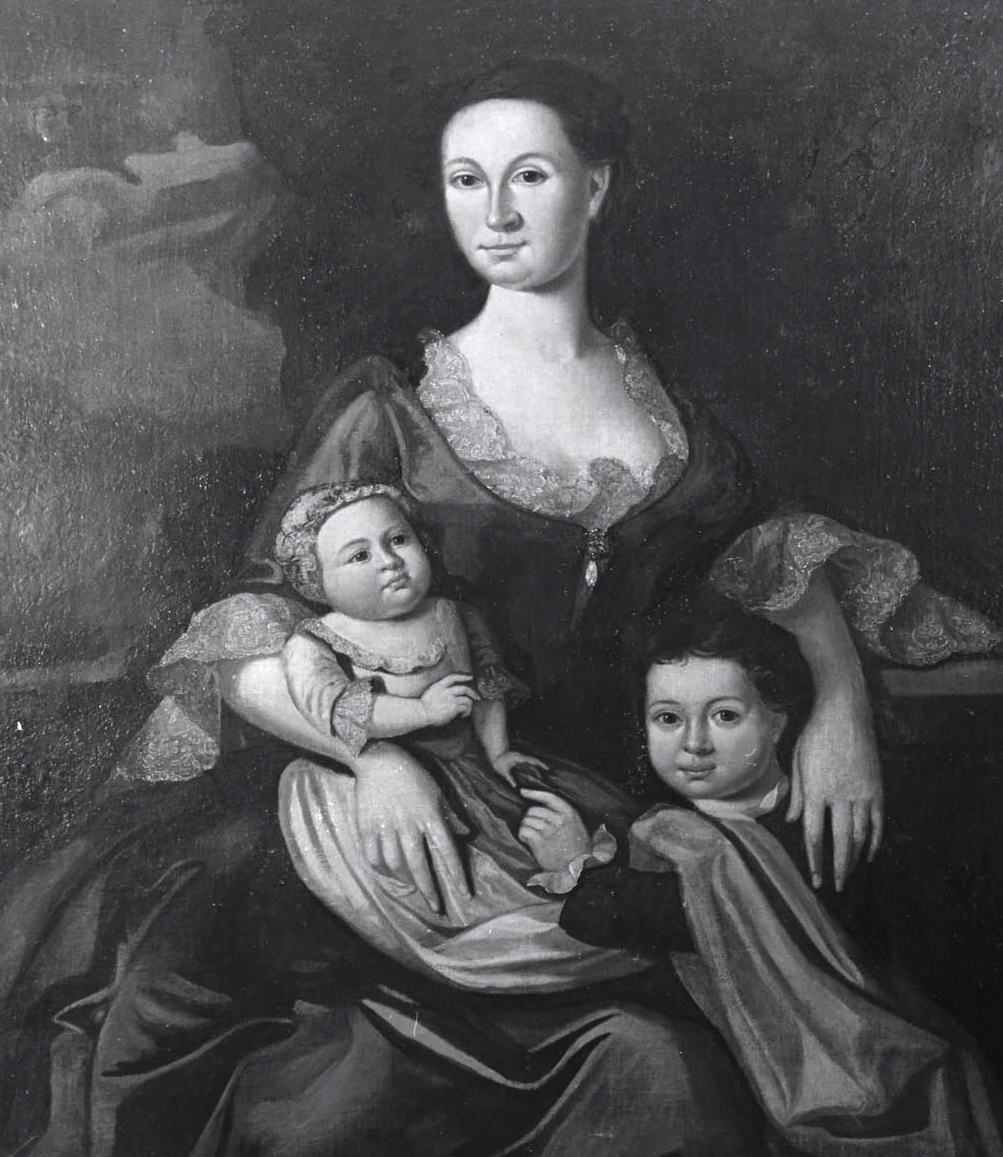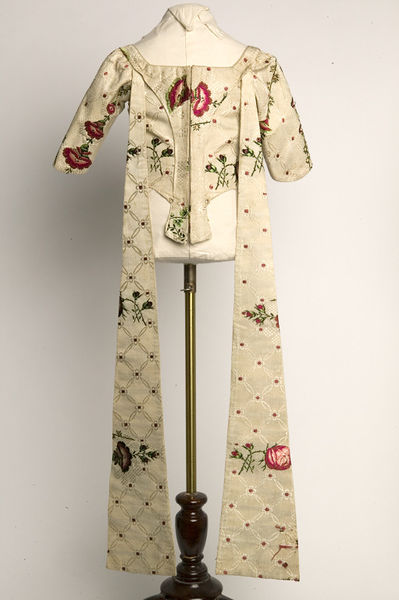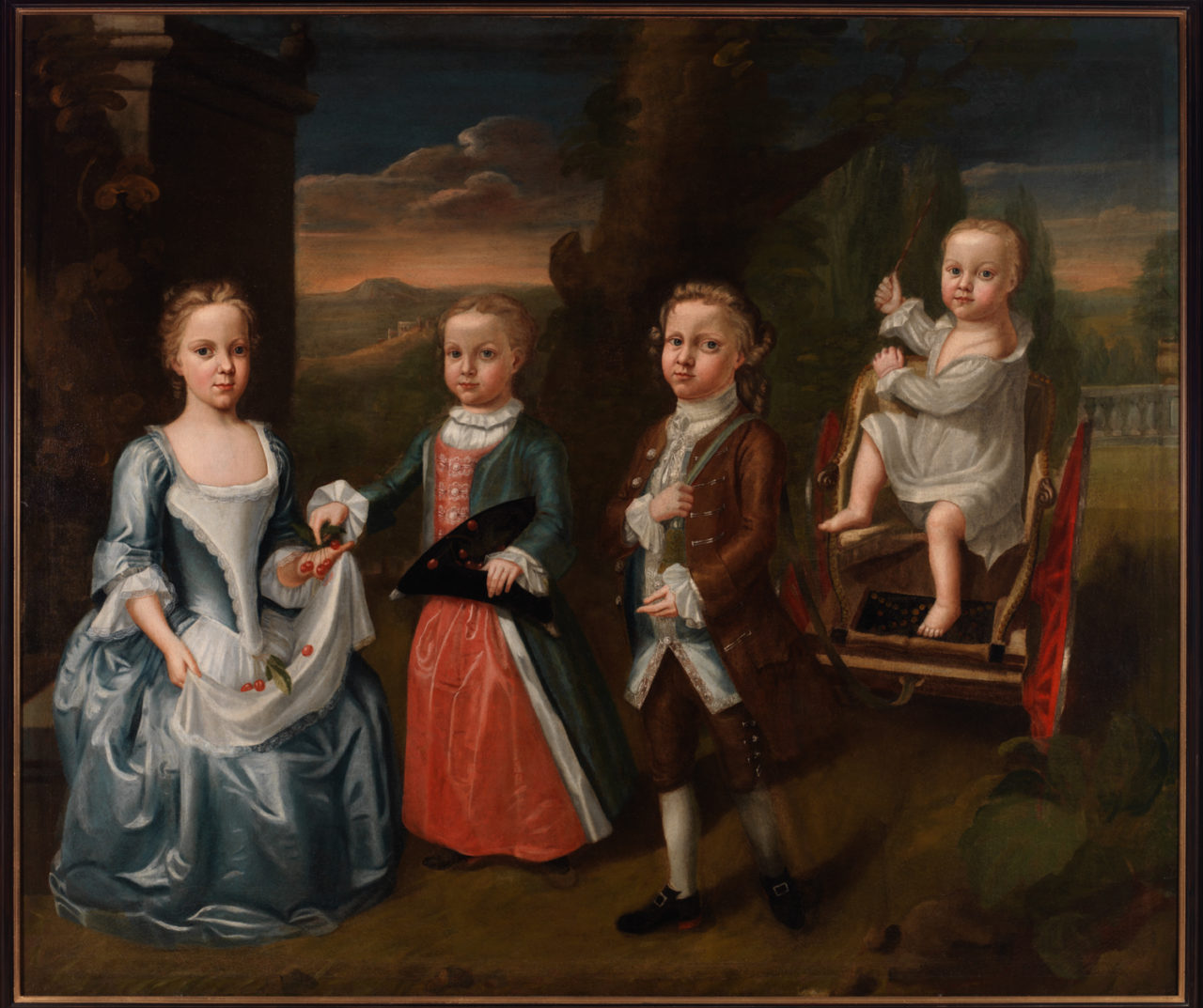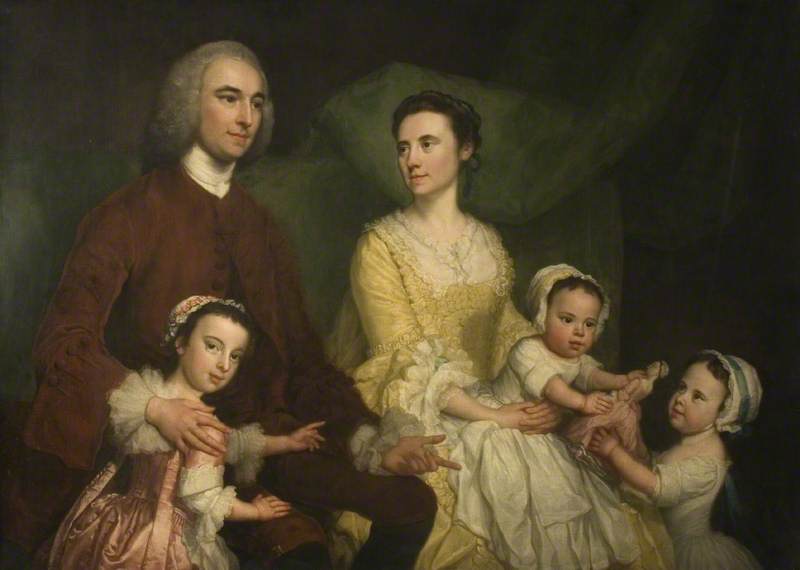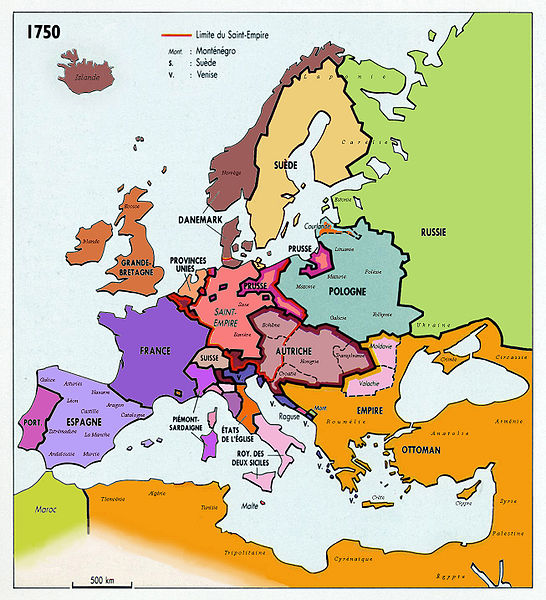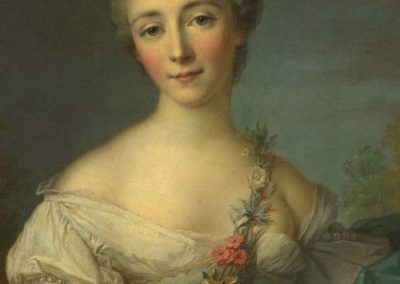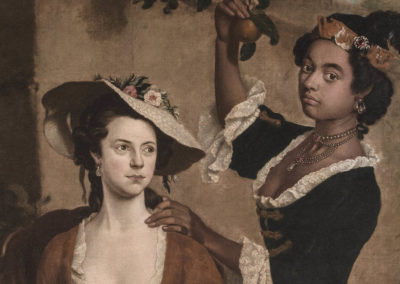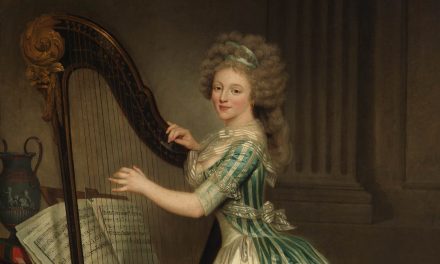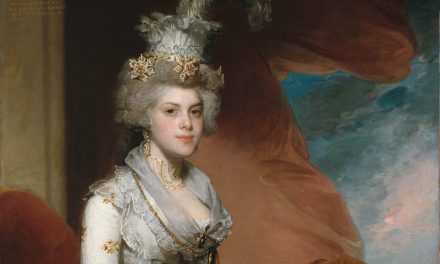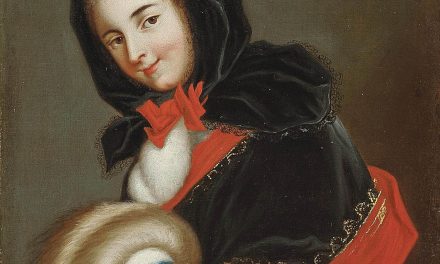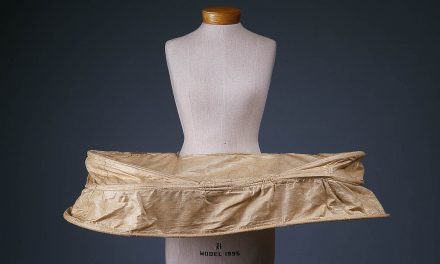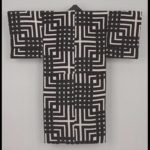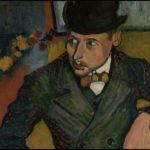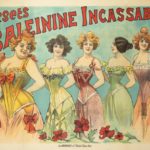OVERVIEW
The mid-eighteenth century marked the height of rococo influence on women’s dress; colorful floral-patterned silk gowns and matching petticoats with three-dimensional trimmings, often applied in serpentine bands, were shown to advantage over wide panniers. During this and the following three decades, the marchande de modes, or milliner, who supplied and artfully arranged these delicate decorations became increasingly important in the creation of a fashionable gown. The coats of men’s three-piece suits became slimmer, losing the extreme side fullness of the 1730s and 1740s, and the waistcoat shortened to mid-thigh. Although wool was favored for daywear, especially among Englishmen, silks and velvets that might be embellished with embroidery or metallic galloon or lace were still obligatory for formal wear.
Womenswear
The robe à la française (Fig. 1), or sack as it was known in England, was the standard garment for women, for both day and evening (Ribeiro 38-9). Established as the dominant form of female dress in the 1730s, the gown changed minimally from that decade until the 1770s, when it was replaced by other, more informal styles. The bodice front, cut separately at the waist since the 1740s, fitted tightly to the torso, and lacing at the back of the linen lining allowed the wearer to pull the dress in closely, while its characteristic box pleats extended across the upper back, falling to a slight hem (Figs. 1, 2, 3). A triangular stomacher of matching woven or embroidered fabric, or decorated with ribbon bows in a form known as an échelle, or ladder, filled in the front opening of the gown (Figs. 2, 4).
Depending on the textiles that ranged from monochromatic taffetas, satins, and damasks to vividly colored brocaded silks with self-figured grounds and the size of the pannier, the robe à la française/sack was worn as an informal garment in the morning and afternoon and a highly formal gown in the evening (Figs. 3, 5)
Fig. 1 - Designer unknown (French). Striped Imberline Robe à la française, ca. 1750. Source: Cora Ginsburg
Fig. 2 - Designer unknown (French). Striped Imberline Robe à la française, ca. 1750. Source: Cora Ginsburg
Fig. 3 - François Hubert Drouais (French, 1727-1775). Portrait of a Woman, Said to be Madame Charles Simon Favart, 1757. Oil on canvas; 80 x 64.8 cm. New York: The Metropolitan Museum of Art. Source: The Met
Fig. 4 - Designer unknown (British). Stomacher, 1740-1760. Linen, silk; 28.5 x 27.5 cm. London: Victoria and Albert Museum, T.720C-1913. Source: V&A
Fig. 5 - François Hubert Drouais (French, 1727-1775). Portrait of the Marquise d'Aguirandes, 1759. Oil on canvas; 101 x 85.6 cm. Cleveland: Cleveland Museum of Art. Source: CMA
In a letter written from London in 1751, Lady Jane Coke referred to the popularity of this type of gown:
“You ask me whether sacks are generally worn; I am so partial to ‘em that I have nothing else—a sack and an apron, with a very small hoop, when I am undressed, and the whole ones when I am to be set out.” (quoted in Buck 26-27)
Although Lady Coke’s apron signaled informality—or “undress”—this would not have been the plain, hardwearing linen or cotton version worn by working-class women and female servants. Silk and fine, embroidered mull aprons were fashionable accessories for affluent women, especially in England (Figs. 6, 7). More informal still was the hip-length jacket bodice, or caraco—a truncated version of the sack—and petticoat combination worn by Mrs. Andrews in a double portrait with her husband by Thomas Gainsborough dating to 1750 (Fig. 8). Until the last quarter of the century when it became stylish everyday wear, this ensemble, based on that of working-class women, was primarily adopted for indoors or for country pursuits (Ribeiro 33).
Fig. 8 - Thomas Gainsborough (British, 1727-1788). Mr. and Mrs. Andrews, ca. 1750. Oil on canvas; 69.8 x 119.4 cm. London: The National Gallery, NG6301. Source: The National Gallery
Fig. 9 - Circle of Donat Nonotte (French, 1708-1785). Portrait of Madame Geoffrin, 18th century. Oil on canvas; 72.4 x 58.4 cm. Source: Doyle
Fig. 10 - Designer unknown (French). Robe à la française, ca. 1740-55. Paris: Palais Galliera, musée de la Mode de la Ville de Paris, 1969.59.1. Source: Galliera
Floral brocaded dress silks remained in vogue throughout most of the eighteenth century, and new designs introduced annually ensured that members of the English and Continental courts and other wealthy consumers regularly renewed their wardrobes to demonstrate their up-to-date fashionable status. As the most expensive type of woven fabrics, these silks appear frequently in female portraiture and their inherent value explains their survival in public and private collections today (Figs. 5, 9, 10). However, plain and striped silks were consistently popular since they did not become outdated as quickly as floral designs. Gainsborough’s Mrs. Andrews (Fig. 8) and Mrs. James and her daughters (Fig. 11), painted by Arthur Devis in 1751, all wear solid-colored silks that were appropriate for daywear, especially in the countryside.
A robe à la française and matching petticoat of yellow-and-white striped imberline (Figs. 1-2)—woven with a silk warp and linen weft—dating to about 1750 illustrates the understated elegance of these patterns. The buttoned compère (false waistcoat) with self-fabric ruching is an early example of this form that increasingly replaced the separate stomacher in the 1760s and 1770s (Figs. 1, 12). The wide pleated sleeve cuffs, known as manches à la raquette (similarly trimmed with self-fabric) are an exaggerated version of the triangular cuffs that were fashionable during the first half of the century. Small, circular lead weights, encased in linen, are stitched to the sleeve lining at the elbow to hold the sleeve in place and to remind the wearer to keep her arms slightly bent in accordance with proper comportment.
Fig. 11 - Arthur Devis (British, 1711-1787). James Family, 1751. Oil on canvas; 122 x 508 cm. London: Tate Gallery. Source: Tate Gallery
Fig. 12 - Jean Étienne Liotard (French, 1702-1789). Marie-Rose de Larlan de Kercadio de Rochefort, Marquise des Nétumières, 1750. Pastel on blue-grey laid paper mounted onto thin paper; 60.3 × 52.1 cm. Detroit: Detroit Institute of Arts Museum, 64.74. Source: DIA
In 1746, at age 8, Barbara Johnson (1738-1825), daughter of a clergyman from Olney, Buckinghamshire, began to meticulously record her wardrobe expenses, affixing swatches of fabrics from each of her gowns onto the pages of a large album (Figs. 13-14), and also noting the yardage that she purchased and the amounts she paid. Compiled on a regular basis until 1823, two years before Johnson’s death, and containing over a hundred samples, the album is an invaluable source of information on the types of fabrics, trimmings, and garments that constituted the fashionable attire of a well-to-do British girl and adult woman in the second half of the eighteenth and early nineteenth centuries. One page (Fig. 13) of the album shows the range of fabrics acquired by Johnson between 1752 and 1756 and their intended use, including a “yellow Tabby” for a “Suit of Cloaths” (a matching gown and petticoat); “a blue water’d [moiré] tabby Nightgown;” “a dark blue Camblet [worsted wool or worsted and silk mixture] riding dress;” “a Grey figur’d Stuff [wool] long Sack second morning for my Grandmother;” “a flower’d [brocaded] silk negligee;” and “a white Lutestring [a lightweight, glossy, plain- woven silk] Night-Gown for second Mourning for my Father.” Johnson would have worn black wool for the first period of mourning following the loss of her grandmother and father; as her purchases indicate, grey and white were permissible for the next phase of bereavement (Buck 60-63). Etiquette regarding the sartorial expression of mourning was stricter for women than for men and the length of time governing the wearing of this specialized dress for both genders “varied in intensity and duration according to the degree of the relationship” with the deceased (Buck 60).
In the first decades of the eighteenth century, the term “nightgown” may have designated a dressing gown worn in the bedroom, but “by the early 1730s, the nightgown appears in a puzzling variety of guises, made of rich and humble fabrics, and sometimes a closed [with an integral petticoat] and sometimes an open gown” (Ribeiro 40). Similarly confusing is Johnson’s reference to her “silk negligee,” which implies an informal garment; however, this “was gradually becoming more a formal gown” with its separate bodice that fit closely around the waist, unlike the earlier robe volante and robe battante that hung loose from shoulder to hem both front and back (Ribeiro 136).
In addition to self-fabric (that may also have been applied by the dressmaker), marchandes de modes availed themselves of a wide variety of materials to ornament their clients’ gowns including silk ribbons, flowers of silk ribbon or silk thread wound around wire, gimp (a type of passementerie), feathers, and knotted silk known as fly fringe. In 1762, Johnson purchased “2 dozen and a half of fringe… at eight shillings a dozen” to match a deep red paduosoy (a plain-woven ribbed silk) for a dress (Figs. 15, 16).
For winter, wealthy female consumers might have selected fur trimming for their garments. A pastel portrait of the Comtesse de Sénozan by Maurice Quentin de la Tour (Fig. 17) shows her in a coral-colored fur-edged velvet robe à la française; Jean-Marc Nattier depicted Madame Adelaïde (Fig. 18), one of Louis XV’s daughters, in a blue velvet grand habit with dark fur trim; and the Comtesse de Tillières (Fig. 19), also painted by Nattier, wears a blue silk sleeved half-cape with a hood trimmed with squirrel. Throughout the eighteenth-century, women’s outerwear consisted of half- or full-length capes of silk or wool that accommodated the voluminous skirts supported by panniers or, in the latter decades, by large crescent pads.
Fig. 13 - Barbara Johnson (British, 1738-1825). Barbara Johnson’s Album of Fashion and Fabrics, 1746-1823. Paper, parchment, textiles; (15 x 9.75 in). London: Victoria and Albert Museum, T.219-1973. Source: V&A
Fig. 14 - Barbara Johnson (British, 1738-1825). Barbara Johnson’s Album of Fashion and Fabrics, 1746-1823. Paper, parchment, textiles; (15 x 9.75 in). London: Victoria and Albert Museum, T.219-1973. Source: V&A
Fig. 15 - Designer unknown (British). Mantua, ca. 1760. Silk, linen; 50.7 cm. London: Victoria and Albert Museum, T.120 to B-1961. Source: V&A
Fig. 16 - Designer unknown (British). Mantua, ca. 1760. Silk, linen; 50.7 cm. London: Victoria and Albert Museum, T.120 to B-1961. Source: V&A
Fig. 17 - Jean Valade (French, 1710-1787). Anne Marie Louise Nicole de Lamoignon de Malsherbes, Countess of Sénozan, ca. 1751. Pastel on blue laid paper; 80.3 × 67 cm. Detroit: Detroit Institute of Arts, 68.173. Source: DIA
Fig. 18 - Jean-Marc Nattier (French, 1685-1766). Madame Adélaïde daughter of Louis XV holding a book of music, 1758. Oil on canvas; 222 x 148 cm. Paris: Louvre Museum, INV 6892. Source: Joconde
Fig. 19 - Jean-Marc Nattier (French, 1685 - 1766). The Comtesse de Tillières, 1750. Oil on canvas; 80 x 63 cm. London: The Wallace Collection, P453. Source: The Wallace Collection
Next to the body, women wore a white linen or cotton chemise that absorbed body oils and perspiration and could be laundered. A rigidly boned corset created the fashionable, conical shape and aided in maintaining an upright posture that conveyed elite status. Whether fully concealed or partially visible, this foundation garment in the wardrobes of affluent women could be highly luxurious. The metallic lace trimming and silk lacing across the separate stomacher of a brocaded silk corset in the collection of the V & A Museum was undoubtedly intended to be seen (Figs. 20, 21). The corset is lined with an early European block-printed cotton and the blue-and-white cotton-covered hip pads would have helped support the gown’s petticoat.
The hoop petticoat, or pannier (Fig. 22), that was instrumental in giving the correct shape to the gown throughout most of the century “was at its widest in the 1740s and 1750s, oblong or fan-shaped” (Buck 27). As noted by Lady Coke in her letter cited above, the largest were worn for the most formal occasions. In 1754, The Connoisseur wryly commented that,
“The hoop has been known to expand and contract itself from the size of a butter churn to the circumference of three hogsheads… At present it is nearly of an oval form, and scarce measures from end to end above twice the length of the wearer.” (quoted in Waugh/Women 117)
A bill, dated August 4, 1757 from “Hoop Maker S. Brown” to Lady Caroline Russell, itemizes the cost of this sizeable understructure for which the price of the silk was twice as expensive as the making of the hoop itself: “To a blue hoop L1.8.0; Paid for eleven yards of lutestring at 6s. per yard L3.6.0; Paid for pinking the flounce 14.0; For flouncing a hoop 14.0; Paid for a hoop box 4.0” (quoted in Waugh/Women 117).
Fig. 20 - Designer unknown (European). Corset, ca. 1750–75. Silk, cotton, wood, baleen. New York: The Metropolitan Museum of Art, C.I.39.13.206a, b. Source: The Met
Fig. 21 - Designer unknown (European). Corset, ca. 1750–75. Silk, cotton, wood, baleen. New York: The Metropolitan Museum of Art, C.I.39.13.206a, b. Source: The Met
Fig. 22 - Maker unknown (British). Woman's Hoop Petticoat (Panier), 1750-1780. Linen, plain weave, cane; 79.375 x 137.16 x 46.99 cm. Los Angeles: Los Angeles County Museum of Art. Source: LACMA
Fig. 23 - Designer unknown (European). Pair of shoes, 1750s-1760s. Brocaded silk, leather; 16 x 8 x 18 cm. London: Victoria and Albert Museum, T.423&A-1913. Source: V&A
Fig. 24 - Maker unknown (European). Pair of stockings, 1750-1775. Silk, frame-knit; 72 x 15 cm. London: Victoria and Albert Museum, T.34&A-1969. Source: V&A
By the 1750s, women’s shoes (Fig. 23) developed a gently rounded toe that replaced the attenuated, upturned toe of the 1720s and 1730s and a high curved heel known in Britain as a “Pompadour” heel, after Louis XV’s official mistress, Madame de Pompadour (Pratt and Woolley 46). Positioned under the instep, the heels would have made walking a challenge—in 1755, the contemporary poet Francis Fawkes described the motion as “tott’ring every step they go”—and forced the weight of the foot onto the toes (Pratt and Woolley 44,46). Throughout the period, well-to-do women wore woven silk or embroidered shoes that might match the fabric of a particular gown, although this was not standard practice. The two latchets that crossed over the long tongue extending over the arch were fastened with a metal buckle that might be set with paste gems or, in the case of a very wealthy consumer, diamonds (Fig. 23). White or colored stockings of knitted silk, cotton, or worsted were often embellished with a long triangular element, known as a “clock,” that was knitted in or embroidered (Fig. 24). Clocks appear in both men’s and women’s stockings, making them difficult to distinguish.
Fig. 25 - Henry Pickering (1740-1771). Eleanor Frances Dixie, ca. 1750-1755. Oil on canvas; 121.9 x 99.1 cm. Nottingham: Nottingham City Museums & Galleries, NCM 1894-112. Source: Art UK
Fig. 26 - Jean-Marc Nattier (French, 1685-1766). Marie-Josephe of Saxony, Dauphine of France (1727-1752), 1751. Oil on canvas; 105 x 120 cm. Versailles: Château de Versailles et de Trianon, MV 2179; INV 6889; B 876. Source: Joconde
In the mid-century, women’s hairstyles were powdered and close to the head. Delicate lace or embroidered muslin caps were worn indoors during the day, while ornaments comprising ribbons, flowers, and/or jewels, introduced by Madame de Pompadour in the mid-1740s and known in England by the French term pompons, adorned the head for formal dress (Ribeiro 156) (Figs. 3, 5, 9, 17, 18, 26, 31). In 1754, Lady Jane Coke commented on the exaggerated influence of French styles and the fashions:
“too various to describe. One thing is new, which is, there is not such a thing as a decent old woman left, everybody curls their hair, shews their neck and wears pink, but your humble servant. People who have covered their heads for forty years now leave off their caps and think it becomes them, in short try to out-do our patterns the French in every ridiculous vanity.” (quoted in Buck 34-35)
For walks in the countryside—a popular activity among the English aristocracy and gentry—wide-brimmed straw hats protected women’s skin (Figs. 8, 25). The ideal pale complexion, perhaps enlivened with rouge on the cheeks, signified a life of leisure rather than one of toil under the sun.
Court wear in England and France (and elsewhere in Europe where French fashions were followed) changed little during the period. As seen in Nattier’s portrait of Madame Adelaïde (Fig. 18), the grand habit, established as obligatory for women at the French court in the early 1680s, was still de rigueur in the mid-century for formal occasions. Apart from the shape of the full-length petticoat that was dictated by that of the fashionable pannier, the three major components of this ensemble—the heavily boned bodice, petticoat, and long train—as well as its requisite lace sleeves and lappets remained the same. However, the selection of an up-to-date richly brocaded silk from Lyon for a grand habit (Fig. 26) would have communicated both the wearer’s awareness of the latest designs and the largesse of her purse—although silk mercers frequently extended generous credit to wealthy clients, who rarely paid their bills on time.
Fig. 27 - Designer unknown (European). Mantua, 1755-1760 (made), 1753-1755 (woven). Silk, linen, silver, gold; 35.5 x 129.5 x 95 cm. London: Victoria and Albert Museum, T.592:1 to 7-1993. Source: V&A
Fig. 28 - Designer unknown (European). Mantua, 1755-1760 (made), 1753-1755 (woven). Silk, linen, silver, gold; 35.5 x 129.5 x 95 cm. London: Victoria and Albert Museum, T.592:1 to 7-1993. Source: V&A
Fig. 29 - François Boucher (French, 1703 - 1770). Madame de Pompadour, 1759. Oil on canvas; 91 x 68 cm. London: The Wallace Collection, P418. Source: The Wallace Collection
Fig. 30 - Maker unknown (Belgian). Pair of Sleeve Ruffles, ca. 1750. Bobbin lace worked in linen thread. London: Victoria and Albert Museum, T.54&A-1949. Source: V&A
Fig. 31 - Sir Joshua Reynolds (British, 1723-1792). Suzanna Beckford, 1756. Oil on canvas; 129 x 794 cm. London: Tate Gallery, N05799. Source: Tate
In England, the now-fossilized, elaborately constructed mantua reached its widest dimensions (Figs. 27-28). As in France, the fashionableness of this archaic form, worn exclusively at court, was evident through its textiles. An impressively lavish mantua in the collection of the V & A Museum is made from a gold-brocaded ivory silk with an unusual dynamic abstract design that may well have been woven in Lyon; since weavers in Spitalfields (London), the center of the English silk industry, kept abreast of and often copied French designs, it is possible that this remarkable textile was produced there (Figs. 27-28).
Lace was an integral component of women’s and men’s dress until the last two decades of the century, when it was still worn for court wear. Although made throughout Europe, French and Flemish laces were the most sought after and the costliest. Fine needle and bobbin laces made of soft linen thread accessorized women’s gowns around the low neckline and at the elbows in the form of single, double, or triple flounces (Figs. 9, 17, 25). Madame de Pompadour (Fig. 29), maîtresse en titre to Louis XV, was an avid consumer of lace. Her inventory, taken at the time of her death in 1764, lists numerous double and triple manchettes (sleeve ruffles / Fig. 30), tour de gorge (a narrow band edging the neckline), caps with lappets, and several decorative flounces for petticoats and a grand habit (Cordey 77-79 CK). These needle and bobbin laces—valued individually in the hundreds of livres and collectively in the thousands—included point d’Argentan (the center of the French needle lace industry), point d’Angleterre (made in Brussels, rather than in England, as the name implies), Valenciennes, and “Maline,” or Mechlin (a town in Flanders) (Cordey 77-79).
In the mid-eighteenth century, blonde lace became popular and was actively promoted by lace-makers and merchants in the Paris region (Levey 56). The term “blonde” refers to the natural-colored silk used to make this type of lace as well as black silk lace (Levey 56). Sir Joshua Reynolds’ portrait of Susannah Beckford (1756) depicts her in a blue-and-silver moiré gown and petticoat with a suite of blue-and-blonde silk bobbin lace comprising a ruff, a triangular shawl, or “handkerchief,” and diaphanous, triple-layered so-called “weeping ruffles,” probably made in France (Levey 70 and fig. 340); the soft sheen of Beckford’s lace accessories compliments that of her lustrous gown (Fig. 31). Linen and cotton whitework—a combination of delicate embroidery and pulled-and-drawn work—was also popular in the middle of the century for women’s accessories (Fig. 3).
The Toilette
In preparation for a day of social activities, the ritual of the morning toilette was customary practice among upper-class women as a signifier of their elite status. While receiving relatives, friends, servants, and other visitors, women performed ablutions such as cleaning their face and hands, had their hair dressed, and applied powder, rouge, and other cosmetics. Pilloried by social commentators and moralists who deplored women’s use of these products to artificially enhance their beauty—or, even more reprehensibly—to disguise their physical imperfections, the toilette appeared frequently in portraiture, genre scenes, and caricatures.
William Hogarth satirized this French “import” in La Toilette, one of six paintings comprising his series, Marriage à la Mode (1743-45) that narrates the ill-fated union of a young couple (Fig. 32). While her coiffeur attends to her locks, the newly minted countess arranges an assignation at a masquerade ball with her lawyer lover, Silvertongue. Behind her, various guests—including an effete-looking man with his own hair in curling papers—sing, play the flute, and drink coffee or chocolate, poured by a Black servant. In “Taste À-La-Mode: Consuming Foreignness, Picturing Gender,” art historian Freya Gowrley examines three Hogarthian motifs—the monkey, the black pageboy, and the coffee or tea service—that communicated the deleterious effects of “the consumption of luxuries imported from abroad” (Gowrley 35). As she notes, the Black pageboy exemplified a “‘cultural object,’ a categorization that refers to the objectification of animate beings… who were both treated and depicted as a sort of living accessory” and signaled “the explicitly gendered understanding of consumerism in eighteenth-century Britain” (Gowrley 35).
In a more positive representation of the toilette, François-Hubert Drouais’s Family Portrait, dated April 1, 1756, depicts an intimate scene of gift-giving, that traditionally took place on that day (Fig. 33). Sitting at her toilette table, the mother wears a white powdering cape while placing a spray of blue flowers on her daughter’s head; the young girl, in turn, offers flowers to her mother; and the girl’s father, leaning on the back of his wife’s chair, reads her a letter or sonnet.
Art historian Melissa Hyde’s examination of François Boucher’s bust-length portrait of Madame de Pompadour (Fig. 34) dating to 1758 investigates the direct and often unfavorable comparisons made in the mid-eighteenth century between the coloristic artifice that characterized Boucher’s individual style as well as rococo painting, in general, and the bourgeoise-turned-marquise’s reliance on “paint” to literally and figuratively make herself up (Hyde 107-44). Equipped with pots and brushes and showing off a bracelet with a cameo portrait of Louis XV, Madame de Pompadour wears a pristine white linen or cotton powdering cape, or peignoir, trimmed with needle lace. Her 1764 inventory lists three peignoirs trimmed with point d’Alençon, four trimmed with point d’Angleterre, and three of embroidered muslin (Cordey 79, 81). These ostensibly informal garments that protected the wearer’s upper body from powder as her coiffure proceeded nonetheless conveyed her wealth in the fineness of their fabric and the richness of their trimmings.
Fig. 32 - William Hogarth (French, (1697 - 1764)). Marriage à la Mode IV: The Toilette, ca. 1743. Oil on canvas; 70.5 x 90.8 cm. London: The National Gallery, NG116. Source: The National Gallery
Fig. 33 - François-Hubert Drouais (French, 1727-1775). Family Portrait, 1756. Oil on canvas; 244 x 195 cm. Washington, DC: The National Gallery of Art, 1946.7.4. Source: NGA
Fig. 34 - François Boucher (French, 1703-1770). Jeanne-Antoinette Poisson, Marquise de Pompadour, 1758. Oil on canvas; 81.2 × 64.9 cm (31 15/16 × 25 9/16 in). Cambridge: Fogg Art Museum, 1966.47. Source: HAM
Fashion Icon: JEANNE ANTOINETTE POISSON, MARQUISE DE POPADOUR (1721-1764)
Throughout her twenty-year tenure as maîtresse en titre to King Louis XV (1715-1774), Madame de Pompadour was a leading tastemaker and fashion trendsetter. Born Jeanne Antoinette Poisson in Paris in 1721 and married in 1740 at age 19 to Charles Guillaume Le Normant d’Etiolles, this beautiful, gifted, and ambitious young woman became mistress to the king in 1745, receiving the title, Marquise de Pompadour. A generous patron of the arts and a strong supporter of Denis Diderot and Jean Le Rond d’Alembert’s Encyclopédie, Dictionnaire raisonné des sciences, des arts et des métiers (1751-1772), Pompadour was both admired and detested during her lifetime by members of the French court and the wider public. A vast scholarly and popular literature attests to the fascination with and recognition of Madame de Pompadour as a woman who wielded enormous political power in mid-eighteenth-century France, whose artistic influence extended well beyond the confines of Versailles and whose legacy persisted long after her death in 1764.
Portraits of the king’s favorite, many by her preferred painter, François Boucher (1703-1770) as well as other leading artists, reveal the graceful elegance that she maintained throughout her life (Fig. 28 in womenswear; Figs. 1-2).
Fig. 1 - Maurice-Quentin de La Tour (French, 1704-1788). Madame de Pompadour, 1751-1755. Pastel; 175 x 128 cm. Paris: Louvre Museum, Inv. 27614. Source: Louvre
Fig. 2 - Francois Boucher (French, 1703-1770). Madame de Pompadour, 1756. Oil on canvas; 212 x 164 cm. Munich: Alte Pinakothek, Inv. Nr. HUW 18. Source: Wikimedia
Fig. 3 - Maker unknown (British). Doll With dress and Accessories, 1755-1760. Wood, silk; 60 x 42 x 43 cm. London: Victoria and Albert Museum, T.90 to V-1980. Source: V&A
Fig. 4 - Maker unknown (French). Doll’s Court Gown, ca. 1769–75. Silk brocade, metal thread, metal lace, spangles, silk ribbon flowers, whalebone; 76.3 × 76.3 × 1.5 cm. Bath: Fashion Museum, BATMC 93.436 to B. Acquired with generous assistance from The Art Fund, and The V&A / Purchase Grant Fund. Source: The Met
One of the most well-known of these—and the only one publicly exhibited during her lifetime—is Boucher’s large canvas dating to 1756, the year of Madame de Pompadour’s controversial appointment as dame du palais of Louis XV’s consort, Queen Marie Leczinska (Fig. 2). Prominently displayed at the Salon of 1757, the painting shows the king’s mistress at the height of her power in a confection-like ensemble that epitomizes the rococo aesthetic in women’s fashion. Reclining on a daybed in a sumptuous interior, Pompadour wears a resplendent green silk robe à la française and matching petticoat extensively trimmed with pink silk roses in a serpentine meander, an échelle of silver-striped pink silk bows and large, matching bows inside each elbow, triple lace engageantes, a pink silk ribbon necklace, multi-strand pearl bracelets, high-heeled pink silk mules with silver lace, and fresh flowers at her left shoulder and in the pompon in her hair. Although the book in her hand, those in the elaborate case behind her, the large red volume on the floor, and other objects including a rolled-up map and portfolios of engravings and drawings point to her intellectual and artistic pursuits, it is her frothy dress that dominates the composition—its pink roses enhance the delicacy of her flawless—cosmetically enhanced—pink-and-white complexion.
Pompadour’s individual style was copied not only by other French women, it also traversed the Channel. In 1748, just a few years after Pompadour’s elevation to maîtresse en titre, Lady Anson, commissioned a fully made-up “Green and White and Gold Sack” from France and, in a letter to a friend, she expressed her regret that “the Poupée [fashion doll] which is coming over dressed exactly like Madame de Pompadour did not arrive time enough for me to be able to adjust my coiffure quite in the Taste it ought to have been in, which indeed was the only thing defective in my appearance” (quoted in Buck 34). Following the doll’s arrival, Lady Anson described the various ensembles that illustrated Pompadour’s fashions in another letter:
“She has three compleat Dresses, one the habit de Sage-Femme, which is de Grande Ceremonie; a Robe (or Sack) pour les Spectacles, les Promenades, etc, etc, and one Robe de negligé for her morning wear; with all sorts of Coiffures, Agréments suited to them all, and written explanations and directions to every part of her Attire.” (quoted in Buck 34)
Before the emergence of a regular fashion press in the last quarter of the eighteenth century, dolls dressed in the latest Parisian styles (Figs. 3-4) served as important transmitters of fashion. Like Lady Anson, women in other European cities eagerly awaited viewings of the newest “poupée” “in the windows of fashionable shops” (Ribeiro 61-62). The 1764 inventory of Madame de Pompadour’s extensive wardrobe includes many “robbe de chambre” and “grand habit,” that likely correspond to the doll’s “negligé” and “habit de Sage-Femme,” respectively. Additional mentions of “robbe” “robe de cour,” and “habit de cour,” all with matching petticoats, suggest the variations and degrees of formality among these dresses that would have been evident through their fabrics and the type and amount of ornamentation (Parmal 27-28). A year before her death, the marquise’s style was still influential. The Enciclopédie Carcassière, ou tableaux des coiffures à la mode gravées sur les desseins des petites-maîtresses de Paris, published in 1763, contains illustrations of forty-four coiffures with such names as “à la Cabriolet,” “à la Jamais vu,” “à l’Accouchée,” and “à la Pompadour.” (Corson 331).
A large-scale portrait of the marquise by François-Hubert Drouais (Fig. 5), completed shortly after her death, records her longstanding consummate style. Working at her embroidery frame in another well-appointed interior with her attentive little canine companion, Madame de Pompadour’s robe à la française with its lavish French needle lace trimmings and engageantes commands the viewer’s attention. The textile with its meandering colorful exotic florals and foliage on a white ground has been identified as either a painted-and-dyed Indian cotton (Watt 92) or a painted Chinese silk (Ribeiro 144). Both Indian cottons and Chinese silks were appreciated by fashionable European women, including Pompadour, who owned a “robbe de chambre de mousseline des Indes rayée à carreaux, avec un petit liseré d’or” (a robe de chambre of Indian muslin patterned with checks, with a small gold border) and a “robbe et son jupon de satin des Indes, fond blanc à bouquets peints” (a gown and petticoat of satin from the Indies, white ground with painted bouquets). Although both textiles are identified as coming from India, the descriptor “des Indes” often referred to fabrics from the East more generally. It is likely that her painted satin dress was of Chinese origin; plain and painted silks were imported to Europe in large quantities in the eighteenth century, while cottons—plain, painted-and-dyed, or block printed—were the most sought-after textiles from India.
Fig. 5 - François-Hubert Drouais (French, 1727-1775). Madame de Pompadour at her Tambour Frame, 1763-4. Oil on canvas; 217 x 156.8 cm. London: The National Gallery, NG6440. Source: The National Gallery
Menswear
Men’s three-piece suits comprising a collarless coat, thigh-length waistcoat, and breeches constituted the essential component of a fashionable wardrobe. In the 1750s, the full-skirted coat decreased in volume and the fronts began to curve away from the lower center front; as a result, the coat was primarily fastened over the chest rather than down to the waist, revealing more of the waistcoat with its inverted V-shaped skirts (Ribeiro 121) (Fig. 11 in womenswear; Figs. 1, 2, 4). The latter garment no longer had sleeves or stiffening at the side and “increasingly, the back part… was cut much shorter than the front” (Ribeiro 122). Although all-matching suits (Fig. 2) were still considered to be the most elegant and would have been expected for court and formal wear, from “the end of the 1740s, the suit… could be made of three different colours and stuffs,” or the coat and breeches might be of the same color and material, worn with a contrasting waistcoat (Ribeiro 124) (Figs. 8, 11 in womenswear; Fig. 4).
Throughout the period, England was known for the quality of its woolen fabrics and Englishmen favored the practicality and durability of these textiles for daywear, especially in the countryside. In the 1740s and 1750s, both Arthur Devis and Thomas Gainsborough were frequently commissioned by members of the landed gentry to record them in the landscapes of their extensive properties, where understated dress reinforced the male sitters’ preference for comfort and informality (Figs. 8, 11 in womenswear). In the latter’s portrait of Mr. and Mrs. Andrews dating to 1750, Mr. Andrews appears in his hunting attire with a pale buff-colored coat with wide revers and a green turned-down collar, an off-white waistcoat, and black breeches—all of wool (Fig. 8 in womenswear). The same artist’s depiction of John Plampin of about 1752 (Fig. 1) nicely illustrates what was considered casual attire for men in mid-eighteenth-century Britain. Seated at the base of a tree with his left arm resting on a conveniently low-hanging branch and his left leg extended on a grassy mound, Plampin wears a frock coat, characterized by its turned-down collar, with narrow gold edging, a white silk waistcoat with gold froggings, and black wool breeches. The National Gallery’s description notes that “the portrait was probably painted around five years before he inherited Chadacre Hall and the manor of Shimpling, Suffolk, in 1757 [and that] Gainsborough shows Plampin on Plampin land…reinforc[ing his] authority and privilege as a member of the British landed gentry, which is presented as part of the ‘natural’ order.” Both men wear the three-cornered hat that was ubiquitous during the period, white linen shirts with plain cuffs, white silk stockings, and low-heeled black leather shoes with buckles.
A mutual disdain and rivalry characterized the Anglo-French relationship throughout the century. The British elite, with their constitutional monarchy and long-established custom of spending much of the year on their country estates with its attendant informal lifestyle and dress, criticized the tyranny of absolute monarchy and ridiculed what they perceived as an overemphasis on elaborate fashions and the constant desire for novelty on the part of the French. In The Gray’s Inn Journal by Arthur Murphy (1753-1754), the author bemoans having to adopt French dress upon his arrival in that foreign land and makes a direct comparison between the comfortable fit of his English frock coat and his liberty and his nation’s form of government:
“Our next Care was to equip ourselves in the Fashion of the Country. Accordingly we sent for a Taylor… to make us two Suits; which he brought us the next Morning at Ten o’Clock, and made complete Frenchmen of us. But for my part… I was so damned uneasy in a full-dressed Coat, with hellish long Skirts, which I had never been used to, that I thought myself as much deprived of my Liberty, as if I had been in the Bastile; and I sighed for my little loose Frock, which I look upon as an Emblem of our happy Constitution; for it lays a Man under no uneasy Restraint, but leaves it in his Power to do as he pleases.” (quoted in Ribeiro 126)
In contrast, for French aristocrats, used to a more formal court-centered lifestyle strictly regulated by complicated etiquette, the English preference for simpler attire seemed to disregard the propriety governing social customs and interactions. In her account of a visit to England in 1750, French traveler Madame de Bocage, remarked on men’s inclination to avoid formal attire, noting that they:
“go out early in the morning, dressed in frocks, either to take a walk or a ride; at their return they generally dine at a tavern; they most of them go incognito to the Play or to Vauxhall; it is not thought necessary to dress except to appear at the Opera or at the places where they are invited to dine.” (quoted in Waugh/Men 104)
Nevertheless, for many young aristocratic and wealthy British men, the Grand Tour of the Continent was part of their formal education. Extended sojourns in France and Italy, visiting and becoming knowledgeable about their art and monuments, especially of classical antiquity, offered these tourists encounters with the refined manners and elegant sociability that distinguished a “Person of Quality.” Unlike Arthur Murphy’s dour assessment of being made into a “Frenchman,” Lord Chesterfield’s letters to his son, who began the Grand Tour in 1750, underscore the importance of acquiring a French polish. Writing on November 12, 1750, he advised his son that,
“When you come to Paris you must take care to be extremely well dressed, that is, as the fashionable people are; this by no means consist in the finery, but in the taste, fitness, and manner of wearing your clothes… Get the best French tailor to make your clothes, whatever they are, in the fashion, and to fit you: then wear them, button them, or unbutton them, as the genteelest people do. Let your man learn of the best friseur to do your hair well, for that is a very material part of your dress. Take care to have your stockings well gartered up, and your shoes well buckled; for nothing gives a more slovenly air to a man than ill-dressed legs.” (quoted in McNeil 19)
Fig. 1 - Thomas Gainsborough (British, 1727-1788). John Plampin, ca. 1752. Oil on canvas; 50.2 x 60.3 cm. London: The National Gallery, NG5984. Source: The National Gallery
Fig. 2 - Sir Joshua Reynolds (British, 1723–1792). Portrait of Francis Beckford, 1755-6. Oil on canvas; 130 x 352.8 cm. London: Tate, N05798. Source: Tate
Fig. 3 - Maurice-Quentin de La Tour (French, 1704-1788). Henry Dawkins, ca. 1751. Pastel on paper mounted on canvas; 66.7 x 53.3 cm. London: The National Gallery, NG5118. Source: The National Gallery
Fig. 4 - Maker unknown (Italian). Suit, 1740–60. Silk, metal, cotton, linen. New York: The Metropolitan Museum of Art, 2009.300.2480a–d. Source: The Met
Fig. 5 - Jean-Étienne Liotard (Swiss, 1702-1789). Portrait of John, Lord Mountstuart, later 4th Earl and 1st Marquess of Bute, 1763. Pastel on vellum; 114.9 × 90.2 cm. Los Angeles: The J. Paul Getty Museum, 2000.58. Source: Getty
Fig. 6 - Designer unknown (Indian). At-home Robe (Banyan), ca. 1750. Cotton plain weave; (center back length: 63 1/2 in). Los Angeles: Los Angeles County Museum of Art, M.2005.42. Costume Council Fund. Source: LACMA
Fig. 7 - Maker unknown (Chinese). Man's At-Home Robe (Banyan), 1750–1760. Silk satin and silk plain weave. Los Angeles: Los Angeles County Museum of Art, M.2007.211.797. Source: LACMA
Maurice Quentin de la Tour’s 1750 portrait of Henry Dawkins (Fig. 3) captured this young man during his stay in Paris en route to Rome. His elegantly curled powdered bagwig (which has left a faint white covering over his shoulders), perfectly tied black silk solitaire around his neck, salmon-colored velvet coat, and silk-and-metal-thread floral brocaded waistcoat convey the distinct signs of a French “makeover.” John, Lord Mountstuart, future first Marquess of Bute, recorded in all his Continental finery by Jean-Etienne Liotard in 1763 (Fig. 5), warms himself in front of a fireplace wearing a matching blue silk suit with elaborate froggings on the high-styled frock coat and waistcoat, trimmed and fully lined with fur (probably squirrel), delicate needle lace jabot and cuffs, white silk stockings that outline his shapely calves—an asset for a man of fashion—and buckled black leather shoes. While Dawkins and Lord Mountstuart may have felt out of ease in Paris or Rome without a powdered bagwig, their compatriots on the other side of the Channel often favored their own, un-powdered hair, especially while on their estates (Figs. 8, 11 in womenswear: Fig. 1). And unlike the plainer versions worn by Robert Andrews and John Plampin with their informal dress, Mountstuart’s feather-fringed three-cornered hat with gold braid loop and button is in keeping with the rest of his luxurious tout ensemble. Barely noticeable at his left side is the hilt of his sword, identified as “the grand distinguishing mark of a fine Gentleman” by The Connoisseur in 1754 (quoted in Cunnington 100).
The mid-eighteenth-century vogue for exotic, imported goods and the influence of Eastern dress are evident in men’s silk or cotton “morning gowns” or “banyans” that could be either loose-fitting, T-shaped garments inspired by Japanese kimono or more fitted to the body with double-breasted closures. A generously cut painted-and-dyed Indian cotton morning gown in the LACMA collection (Fig. 6) is made from two continuous pieces of fabric, seamed at the center back, that accommodate the directional elements of the large flowering vases; reversing at the top of the shoulders, the motifs are right side up both front and back. The center front opening, sleeve edges and hem feature specially designed borders, completing the sophisticated composition. Also held by LACMA is a banyan of green silk damask (Fig. 7) with an outsized repeat of stylized flowers and leaves woven in China; the close-fitting tailoring, however, takes its cue from Indian men’s garments. Although worn at home for informal occasions in the presence of other family members, servants, or tradespeople, these gowns provided an opportunity for the display of wealth and taste.
CHILDREN’S WEAR
(BY SUMMER LEE)
Leading into the eighteenth century, new philosophies emerging from the Age of Enlightenment were changing attitudes about childhood (Nunn 98). For example, in his 1693 publication, Some Thoughts Concerning Education, John Locke challenged long-held beliefs about best practices for child-rearing. A slightly later child development theorist was Jean Jacques Rousseau. Locke and Rousseau both put forwards general principles about children’s dress. However, their ideas were not clearly reflected in childrenswear until the second half of the century.
Swaddling was a very long-held European tradition where an infants’ limbs are immobilized in tight cloth wrappings (Callahan). The Victoria and Albert Museum possesses a finely embroidered swaddling band dated circa 1700-1750 (Fig. 1). Its elaborate floral embroidery indicates that this was a fashionable “outer swaddling band” (Victoria and Albert Museum). However, Locke and Rousseau believed that swaddling infants was bad for health and physical strength (Paoletti). While the tradition was continued throughout the first half of the century, the practice did begin to decline in the second half.
Babies were then dressed in “slips” or “long clothes” until they began to crawl (Callahan). These were ensembles with very long, full skirts that extended beyond the feet (Fig. 2) (Nunn 99). Babies also wore tight-fitting caps on their heads. Locke and Rousseau advocated that young children receive more regular hygiene. They also believed that dressing children in many layers of heavy fabrics was bad for their health. For those reasons, linen and cotton fabrics were preferred for babies and very young children because they were lightweight and easily washable (Paoletti).
Once a child was becoming mobile, they transitioned into “short clothes” (Callahan). These ensembles ended at the ankles, allowing for greater freedom of movement (Callahan). In the 1750s short clothes still featured a boned or stiffened back-opening bodice, though they were less structured by the 1760s (Callahan).
At this phase, toddlers typically had “leading strings” attached to the back of their bodices (Fig. 3) (Magidson). Leading strings were streamers of fabric used to protect young children from falling or wandering off (“Childhood”).
When boys were deemed mature enough, they underwent a rite of passage known as “breeching” (Reinier). Breeching referred to the first time a boy wore bifurcated breeches or trousers, symbolizing his entrance into manhood. In the first decade of the eighteenth century, boys were typically breeched between the ages of four and seven (Callahan). From that point on, boys during this time followed menswear fashions. Girls did not fully transition into adult dress until their early teens. However, elements of fashionable womenswear were incorporated into their dress as they aged.
Fig. 1 - Designer unknown (French). Swaddling band, 1700-1750. Hand embroidered linen; 340.5 cm x 12.5 cm. London: Victoria and Albert Museum, B.13-2001. Source: Victoria and Albert Museum
Fig. 2 - John Hesselius (American, 1728–1778). Anne Byrd Carter (Mrs. Charles Carter, 1725-1757) With Two Children, ca. 1750-1757. Winston-Salem, NC: Museum of Early Southern Decorative Arts, MESDA Object Database record S-5126. Source: Colonial Virginia Portraits
Fig. 3 - Designer unknown (English). Dress bodice, 1750-1759. Spitalfields silk. London: Victoria and Albert Museum, 162-1899. Given by Mrs Morgan. Source: Victoria and Albert Museum
Fig. 4 - John Hesselius (American, 1728–1778). The Grymes Children, ca. 1750-1755. Oil on canvas; 142.24 x 167.64 cm (56 x 66 in). Richmond: Virginia Museum of History & Culture, 1893.3. Source: Colonial Virginia Portraits
Fig. 5 - George Knapton (English, 1698–1778). Dr Samuel Walthen with His Wife and Children, 1755. Oil on canvas; 114.7 x 160.8 cm. Birmingham: Birmingham Museums Trust, 1952P8. purchased from Martin Asscher, 1952. Source: Art UK
An American painting circa 1750-1755 depicts four children of Philip Grymes and Mary Randolph Grymes (Fig. 4). From left to right, they are Lucy, John, Phillip, and Charles. Lucy wears a blue gown with a back-opening bodice and white apron. Extremely similar ensembles can be seen in portraiture of young girls throughout this decade, as well as previous decades. John also wears a gown, signifying that he has not yet been deemed mature enough to be breeched. Nonetheless, his ankle-length red gown and blue coat appear influenced by menswear. John also holds a fashionable tricorne hat in his left hand. Phillip is only one year older than John, yet he wears a brown men’s suit with a light blue waistcoat. Charles, the smallest child, may have been as young as two at the time of painting. He wears a short, loose white gown — seemingly in line with the philosophies of Locke and Rousseau.
A 1755 family portrait of Dr Samuel Walthen with his wife and children is another excellent visual resource for 1750s childrenswear. The youngest child wears a white gown with a stiffened bodice and a tight cap on their head. They are fascinated by a doll being held by the second-youngest child, who also wears a white gown and fitted cap. The oldest child, on the left, wears a fitted cap and a pink gown with clearly visible leading strings.
REFERENCES:
- Buck, Anne. Dress in Eighteenth-Century England. London: B. T. Batsford, 1979. http://www.worldcat.org/oclc/1148934170.
- Callahan, Colleen R. “Children’s Clothing.” In The Berg Companion to Fashion, edited by Valerie Steele. Oxford: Bloomsbury Academic, 2010. Accessed August 08, 2020. http://dx.doi.org/10.5040/9781474264716.0003223.
- “Childhood.” In European Renaissance and Reformation, 1350-1600, edited by Norman J. Wilson, 319-321. Vol. 1 of World Eras. Detroit, MI: Gale, 2001. Gale eBooks (accessed August 7, 2020). https://libproxy.fitsuny.edu:2653/apps/doc/CX3034600137/GVRL?u=fitsuny&sid=GVRL&xid=480f4328.
- Cora Ginsburg Costume Textiles Needlework. 2016. http://www.worldcat.org/oclc/495709147.
- Cora Ginsburg Costume Textiles Needlework. 2004. http://www.worldcat.org/oclc/1075297168.
- Cora Ginsburg Modern. 2016. http://www.worldcat.org/oclc/936212471.
- Cunnington, C. Willett. Handbook of English Costume in the Eighteenth Century. London: Faber, 1972. http://www.worldcat.org/oclc/751792955.
- Cordey, Jean. Inventaire des biens de Madame de Pompadour: rédigé après son décès. Paris: F. Lefrançois pour la Société des bibliophiles français, 1939. http://www.worldcat.org/oclc/458907713.
- Dyer, Serena. “Barbara Johnson’s Album: Material Literacy and Consumer Practice, 1746-1823.” Journal for Eighteenth-Century Studies. 42.3 (September 2019): 263-282. https://doi.org/10.1111/1754-0208.12616.
- Gowrley, Freya. “Taste à-la-Mode: Consuming foreignness, picturing gender.” In Materializing gender in eighteenth-century Europe, eds. J. G. Germann and H. A. Strobel, 73-80. Abingdon: Routledge, 2016. https://derby.openrepository.com/handle/10545/624373.
- Hyde, Melissa. Making up the Rococo: François Boucher and his Critics. Los Angeles: Getty Research Institute, 2006. Chapter Three: “The Makeup of the Marquise,” 107-144. http://www.worldcat.org/oclc/474739698.
- Jones, Colin. Madame de Pompadour: Images of a Mistress. London: National Gallery, 2002. http://www.worldcat.org/oclc/1150271464.
- Kammel, Frank M, and Johannes Pietsch. Structuring Fashion: Foundation Garments Through History. Munich, Hirmer, 2019. http://www.worldcat.org/oclc/1121193756.
- Lee-Whitman, Leanna. “The Silk Trade: Chinese Silks and the British East India Company.” Winterthur Portfolio 17, no. 1 (1982): 21-41. Accessed July 12, 2021. http://www.jstor.org/stable/1180762.
- Lever, Evelyne. Madame de Pompadour: A Life. New York: Farrar, Straus and Giroux, 2003. http://www.worldcat.org/oclc/54032733.
- Magidson, Phyllis. “Fashion.” In Encyclopedia of Children and Childhood: In History and Society, edited by Paula S. Fass, 344-348. Vol. 2. New York, NY: Macmillan Reference USA, 2004. Gale eBooks (accessed August 7, 2020). https://libproxy.fitsuny.edu:2653/apps/doc/CX3402800166/GVRL?u=fitsuny&sid=GVRL&xid=0084684d.
- McNeil, Peter. Fashion: Critical and Primary Sources. The Eighteenth Century. Oxford and New York: Berg, 2009. http://www.worldcat.org/oclc/958721947.
- Mitford, Nancy. Madame de Pompadour. New York: Harper & Row, 1968. http://www.worldcat.org/oclc/251465404.
- Nunn, Joan. Fashion in Costume 1200-2000. Bridgewater, NJ: Distributed by Paw Prints/Baker & Taylor, 2008. http://www.worldcat.org/oclc/232125801
- Paoletti, Jo Barraclough. “Children and Adolescents in the United States.” In Berg Encyclopedia of World Dress and Fashion: The United States and Canada, edited by Phyllis G. Tortora, 208–219. Oxford: Bloomsbury Academic, 2010. Accessed August 28, 2020. http://dx.doi.org/10.2752/BEWDF/EDch3029.
- Parmal, Pamela. Translation and Explication of the Inventory of Madame de Pompadour taken after her death in 1764. Master’s Thesis. FIT, 1987. http://www.worldcat.org/oclc/79202170.
- Pratt, Lucy, and Linda Woolley. Shoes. London: V & A Publications, 1999. http://www.worldcat.org/oclc/603674113.
-
Rasche, Adelheid. “18th Century Hoop-Petticoats: German Sources and Two Surving Examples.” In Structuring Fashion: Foundation Garments through History, edited by Frank Matthias Kammel and Johannes Pietsch, 109-119. Munich: Bayerisches Nationalmuseum, 2019. http://www.worldcat.org/oclc/1224313215.
- Reinier, Jacqueline S. “Breeching.” In Encyclopedia of Children and Childhood: In History and Society, edited by Paula S. Fass, 118. Vol. 1. New York, NY: Macmillan Reference USA, 2004. Gale eBooks (accessed August 7, 2020). https://libproxy.fitsuny.edu:2653/apps/doc/CX3402800074/GVRL?u=fitsuny&sid=GVRL&xid=360a7a45.
- Ribeiro, Aileen. Dress in Eighteenth Century Europe. New Haven and London: Yale University Press, 2002. http://www.worldcat.org/oclc/873114892.
- Rothstein, Natalie. Silk Designs of the Eighteenth Century in the Collection of the Victoria and Albert Museum, London. Boston: Little, Brown, 1990. http://www.worldcat.org/oclc/643770082.
- Rothstein, Natalie. Barbara Johnson’s Album of Fashion and Fabrics. New York: Thames and Hudson, 1987. http://www.worldcat.org/oclc/450971000.
- Victoria and Albert Museum. “Swaddling Band.” V&A Collections. Accessed August 08, 2020. http://collections.vam.ac.uk/item/O62960/swaddling-band/.duction-to-20th-century-fashion/.
- Waugh, Norah. The Cut of Men’s Clothes. New York: Theatre Arts Books, 1964. http://www.worldcat.org/oclc/756979502.
- Waugh, Norah, and Margaret Woodward. The Cut of Women’s Clothes, 1600-1930. London: Faber, 1968. http://www.worldcat.org/oclc/426220532.
Historical Context
Wikipedia: 1750-1759
Rulers:
- France: Louis XV (1715-1774)
- England: George II (1727-1760)
- Spain: Ferdinand VI (1746-1759)
Map of Europe in 1750. Source: Wikimedia Commons
Events:
- 1750 – Jean-Jacques Rousseau’s Discourse on the Arts and Sciences
- 1752 – Gregorian calendar adopted
- 1759 – Voltaire’s Candide is written
Primary/Period Sources
Resources for Fashion History Research
To discover primary/period sources, explore the categories below.
Have a primary source to suggest? Or a newly digitized periodical/book to announce? Contact us!
Fashion Plate Collections (Digitized)
- Costume Institute Fashion Plate collection
- Casey Fashion Plates (LA Public Library) - search for the year that interests you
- New York Public Library
Etiquette Books (Digitized)
Secondary Sources
Also see the 18th-century overview page for more research sources… or browse our Zotero library.

